The Battle of Automatic Chronographs – IWC vs. Glashütte Original (the White Dial Edition)
Two clean, technical but far from cold watches face-to-face, and some of the best luxury automatic chronographs around!

This face-to-face article wasn’t something we actually planned to do… But recently, after shooting photos for the review of the Glashütte Senator Chronograph Panorama Date, I put the watch on my desk, right next to another chronograph… A white dial IWC Portugieser Chronograph 3714. And that’s how the idea for this battle of automatic chronographs emerged. Two slightly Germanic-looking watches, with white dials, elegant but not over-dressed designs, from two of the most respected brands. This is not going to be an easy battle!
In the left corner, the modern icon in IWC’s collection, the classic Portugieser Chronograph reference 3714 with white dial and blue indexes – the one with a Valjoux-based movement. In the right corner, another desirable watch, much more recent, with solid arguments regarding its movement, the GO Senator Chronograph in steel with a casual white dial. As with all our face-to-face articles, we reviewed both models first – here for the IWC Portugieser Chronograph and here for the Glashütte Original Senator Chronograph – just to be sure we didn’t miss anything on the side of the road. And as with all our battles, before we give you a clear verdict (if ever I manage to do that), we have to look at all the aspects of these (both great) watches in an impartial way.
CASE, DESIGN AND WRIST PRESENCE
Before we look at the cases and designs in more details, these two watches are, at first glance, very close in terms of spirit… But not in terms of execution. A quick overview won’t do justice on just how different these watches actually are. If we go down to the smallest details, the philosophy behind the Glashütte Original is different from what you’ll find in the IWC. And that’s why this comparative review needs to be thorough, otherwise, we could easily miss the point.
To start with this face-to-face, we first need to review the case and overall design. The IWC Portugieser is a classic watch, almost unchanged since its introduction over 20 years ago, in 1998 – and in fact, the design even goes back to the 1995 IWC Portugieser DoppelChronograph Ref. 3712, as the 3714 is, design-wise, the same watch without the split-seconds pusher. This means that we’ve had quite a lot of time to become familiar with this elegant, timeless chronograph watch. No surprises here.
The case of the IWC Portugieser Chronograph 3714 measures 40.9mm in diameter, with a restrained height of 12.6mm – which is on the thin side for an automatic chronograph. The lug-to-lug dimension is around 47mm and the caseback is domed, thus absorbing some the thickness. The lugs are quite long but curved enough to result in a compact watch.
As I explained in my review of this watch, it is a clean, discreet and rigorous model – something that befits the 1990s version of IWC, under the influence of Günter Blümlein. You only start to appreciate the Portugieser once you’re wearing it. The beauty of the 3714 is that it is a bezel-less watch, with an ultra-wide crystal that covers the entire surface of the case – and is even larger, as the bezel tapers when joining the casebands.
The rest of the watch feels classic, solid, well executed and not overly designed like some of the IWCs produced during the late 2000s. The sides are brushed, the flat surfaces and pushers/crown are polished, the caseback is plain. It is neat, sleek and far from demonstrative – and I mean it in the best possible way.
The Glashütte Senator Chronograph Panorama Date is a much younger watch, which was first presented in 2014 in gold. In 2017, it came in steel with a black dial and last year, the brand added the model we have here for our review, with a white dial. Now, being a watch produced in Saxony, there are rules to respect and a Germanic sense of clean design is thus a prerequisite. In this instance, the case of the GO Senator Chronograph doesn’t disappoint.
Design-wise, the case of this Senator watch is on the clean and technical side of things. The bezel is thin, the lugs are, in the classic Saxon way, relatively strong and wide, but in the case of this watch, short, curved and compact. The case combines brushed surfaces and polished accents, all greatly executed, with clear demarcation lines between the surfaces. One nice detail is to be found on the side, with its well-integrated pushers: they are non-intrusive, both visually and when wearing the watch.
Now, let’s talk proportions. The Senator Chronograph Panorama Date is on the large side, with a case measuring 42mm in diameter, which isn’t that much of an issue considering the 48mm lug-to-lug dimension and the very compact lugs. The main difference with the IWC comes from the 14.6mm thickness of this GO. This can be explained by the sapphire caseback and, mostly, by the movement inside of the case – but more on that later. Don’t expect to slip it discreetly under your cuff. In this instance, the GO is more casual than the IWC.
On the wrist, these two watches offer great comfort. As said, the cases feature curved lugs which make them well-balanced. One of the main positive aspects of the IWC is this ability to combine the best of both worlds: the comfort of a relatively small watch with the sensation of having a large piece on the wrist. Presence on one side, comfort on the other.
On the other hand, the GO will require a larger wrist. In reality, it isn’t much larger than the IWC (remember that the 40.9mm concerns the case, not the bezel), so all in all, both watches feel equal. However, having a wider bezel and a higher case, the Senator has more presence on the wrist and is heavier. I have photographed both on my (small) 16.5cm wrist and you can see that the GO is larger – yet still comfortable and perfectly balanced.
Conclusion: Both watches are greatly designed. Both are classic, timeless pieces that won’t go out of fashion in the coming years – always important when investing such amounts in a watch. A funny aspect is that, from these two, the most “Teutonic” is actually the Swiss watch (OK, it comes from the German-speaking part of Switzerland) and the GO has a more refreshing, less strict design compared to the IWC.
In terms of overall execution, there’s no clear winner here. The GO might be a tad more precise in assembly and refined in finishing. But the height of the Senator can be problematic for some. The IWC is more discreet, more restrained. I’d say that the IWC wins a point here, but not by much. It’s a very close battle.
Dial and display
Here again, at first sight, both the IWC Portugieser Chronograph reference 3714 and the Glashütte Senator Chronograph Panorama Date share the same spirit: playing on symmetry and balance, with white dials and dark contrasting accents, with a casual/elegant (and not sporty) feeling. But once again, it’s all about details.
The IWC, while being powered by a movement based on a Valjoux architecture, features a different display. This watch is all about symmetry, even for its dial, which might strike some as rigid and strict. The idea with the IWC is to draw a line from 12 to 6 o’clock and each side echoes the other, all the way down to the inscriptions on the dial. It is balanced, elegant and pleasant to the eye.
Regarding the dial, the version we have here is the slightly nautical model, with blue accents. Still, it features the same dial as the iconic version with golden accents. The base for the dial is a slightly metallic silvery-white colour with a glossy finish. In certain conditions, the dial even shimmers ever so slightly and plays well with the ambient light – it goes from a warm white to a cold, steel-like colour. The Arabic numerals are well executed, though not applied on the dial but stamped.
The hands of the IWC are a tribute to the earliest models, with a leaf profile. All the hands are extremely thin and refined, with a deep blue colour. Legibility is superb in almost all conditions, without reflections, but only during the day. The IWC does not feature a single luminous spot. This, once again, confirms the more formal vocation of this watch. As for the display, the IWC relays the very essence of a chronograph, with only the hours and minutes, a small seconds, a central chronograph hand and a 30-minute counter. Voilà… no additional features here.
Concerning the Glashütte Original, there’s more going on with this watch, and not only in terms of display. First of all, while the IWC feels very formal in this aspect, the GO is more casual. It features baton hour markers and luminous material on both the indexes and the main hands. Also, the black-on-white scheme is not as dressy as the IWC.
The dial of the Senator is, as always with GO, manufactured in-house in a dial factory based in Pforzheim. It is a rare thing in the watchmaking industry. And looking at the dial in detail, you understand that it makes sense. The surface of this milky-white dial has a slightly grained texture with perfectly defined inscriptions. The sub-dials are circled by a metallic frame, adding depth and appeal. A white and black dial might seem fairly basic to some, but in this context, it provides the best contrast for legibility and at the same time conveys a certain sense of authority. The matte and luminous dial means that it can be used day and night. My only concern is the Roman numerals at 12 and 6 o’clock… Simple batons would have been more relevant, I think.
Display-wise, the GO is far more complex. Certainly, it manages to bring multiple indications in a very symmetric and clean way. A surprising element is the position of the third sub-counter, at 12 o’clock, when it is usually positioned at 6 o’clock on most chronograph watches… But this was done to allow room for the large Panorama Date. In addition to that, it also features a power reserve indication and its chronograph combines 30-minute and 12-hour counters.
Conclusion: As much as I love the austerity of the IWC’s display, the beauty of the fonts and the reflections that its glossy dial offer, when it comes down to making an objective choice, it is a clear win for the Glashütte Original. Not only does the dial provide superb contrast, but it is also luminous… More functions for sure, but this dial is playing in a different league when it comes to execution. The precision of the printings, the details all around, the great texture… I know GO are proud of manufacturing their dials in-house, and they should be!
Movements
This is where these two watches differ most. While their “bodyworks” could feel rather equal in design and execution, when it comes to what’s under the hood, major differences are to be seen. And that requires an explanation.
Back when the IWC was introduced, in 1998, the notion of in-house movements was not yet as important as it is today. Only a few ultra-high-end watchmakers were manufacturing chronograph movements internally – you can read this article, it will provide a complete overview of this specific topic. This was only 20 years ago but the norm was still to rely on Valjoux/ETA/Lemania/Dubois-Depraz for chronograph movements. IWC only introduced its first in-house integrated chronograph, the 89xxx series, back in 2007. This explains the movement found in the IWC Portugieser Chronograph 3714.
The key element to the relative accessibility of the IWC Portugieser Chronograph 3714 lies in its relatively simple Calibre 79350. It is based on a Valjoux 7750 architecture. The words “based on” are extremely important here. Some might think that IWC just puts a simple Valjoux in the case, but in fact, the base movement is extensively modified, to meet with IWC’s standards.
First, the display is different; the 12-hour counter has been removed and the small seconds sub-dial placed at 6 o’clock (instead of 9 o’clock on a standard 7750), which implies repositioning multiple gears and trains, adding pins and levers and creating a new baseplate. Also, the date mechanism has been entirely removed – no “ghost” position on the crown. Finally, the Calibre 79350 features 31 jewels, instead of the 25 jewels on a 7750 – proof of all the modifications executed on the movement. Finally, some of the parts have been upgraded to a higher quality, specifically the escapement, the balance and the hairspring, to offer better chronometric results.
For daily use, the movement of the IWC offers an accurate indication of the time – even though not COSC-certified, although the example we have met with the standards. The pushers offer, as always with the 7750 architecture, a robust, very mechanical feeling – but not really any noblesse.
On its part, Glashütte Original deploys its heavy artillery in its Senator Chronograph. In-house, integrated, automatic, column wheel, flyback! Introduced in 2014, the Calibre 37 is GO’s top-tier chronograph engine (next to the hand-wound Panograph) with modern architecture, superb decoration and layout and multiple delicacies.
The movement is superbly designed, with half of the main-plate offering a view on the multiple gears and levers that compose the chronograph part of this movement. The solutions used are impressive: column wheel for the actuation of the functions, resulting in the smooth operation of the pushers, an oscillating pinion (instead of a horizontal or vertical clutch) providing immediate starts and improved accuracy, a flyback function and a power reserve of 70 hours. It also features a Panorama Date, adjusted by the crown.
The sapphire caseback adds immense appeal to the watch with a view on the great decoration. This means the traditional Glashütte three-quarter plate, the swan-neck fine adjustment, a skeletonized rotor with a 21k gold oscillating weight decorated, along with the bridges, with thick Glashütte ribbing, blued screws and bevelled and polished edges.
Conclusion: No debate! One point for the Glashütte here. Even though IWC employs great effort in adjusting the Valjoux base to its standards, with numerous modifications and improvements, it can’t beat the noblesse of GO’s Calibre 37. Period.
Now, this has to be nuanced… The Calibre IWC 79350 movement has several advantages over the Glashütte Original Calibre 37. First, it is thinner and thus allows for a sleeker watch. Then, as one of the most produced movements, it is easy to maintain and service. Finally, it is reflected in the substantially lower price…
Strap/Buckle & comfort
The straps found on the IWC Portugieser Chronograph 3714 and the Glashütte Original Senator Chronograph Panorama Date perfectly define the vocations of each watch.
The IWC is equipped with a slightly more formal alligator strap. Still, on this blue version, it is a bit bolder than the classic black leather found on the model with golden accents. Its colour isn’t uniform and looks slightly “washed” – darker on the periphery of the scales and lighter in the centre. Even though it is not crafted by Santoni, the quality of this strap is superb. Thick but not stiff, it immediately hugs the wrist and doesn’t need an adaptation period before becoming comfortable.
The strap comes with a nicely finished folding clasp, with brushed and polished surfaces. Once again, the execution is serious and solid. The clasp is also comfortable and well positioned.
The Glashütte Original plays on more casual notes. It is delivered on a smooth calfskin brown leather strap with off-white contrasting stitchings, adding a bit of a vintage vibe to this watch. As such, it feels more weekend than business. The quality of the strap is great; smooth to the touch and supple on the wrist. It felt comfortable right out of the box.
Here too, the GO is worn on a beautifully finished folding clasp, with brushed and polished surfaces. The execution is serious and solid, on a par with the rest of the watch. The clasp is comfortable and well positioned.
Conclusion: No winner here for the strap/buckle combo, as both watches are equally well finished. However, there’s a different philosophy in the choice of leather and colour, which reflects the vocation of these watches. But that is an entirely subjective choice.
In terms of comfort, I’d say that it depends on the size of the wearer’s wrist. Considering my small wrist, the IWC feels more appropriate and better balanced. Now, for a man with an average 18cm wrist, both watches will offer great balance and comfort.
Pricing
This is the major point of discussion between these two watches. There’s a huge gap in price between the IWC and the GO, which can’t be overlooked in this review.
The IWC Portugieser Chronograph 3714 has a retail price of EUR 7,600, whichever steel version you choose – ref. IW371445 silver-plated dial with golden indices, ref. IW371446 silver-plated dial with blue indices, ref. IW371447 black dial with rhodium-plated indices, or ref. IW371491 blue dial with rhodium-plated indices. It is widely available.
The Glashütte Original Senator Chronograph Panorama Date in steel retails for EUR 13,200. It is available in multiple versions, with a white or black dial, with a leather strap, a rubber strap or a steel bracelet.
Conclusion: The price difference will exert a major influence on the choice here… No debate. Still, both prices seem fair, considering that the difference can easily be explained by multiple factors, the main one being the far more complex movement found in the Glashütte Original. Also, its dial is better executed and, overall, there’s a better feeling of quality with the GO (not by much, though).
Conclusion
Let’s be honest, once you put the price in the equation, this battle of white-dial automatic chronographs becomes much more complex. Thus, I’m going to make two conclusions.
First is my personal, subjective take – in short, the watch I would buy myself… And it’s the IWC. Why? It comes down to two reasons, the first based purely on aesthetics. I personally love the austere, clean and Germanic feel of the 3714 and its timeless appeal. The reflections on the dial are very pleasant and the shape of the Arabic numerals, combined with the leaf-shaped hands, have always attracted me. Second, considering I have a smaller wrist, I think the IWC is a wiser choice, resulting in a more balanced, more elegant watch.
Now, if I have to be objective, the Glashütte Original is, in many aspects, a better watch. The movement is playing in a totally different league and the execution of the dial is one step further. The additional functions (Panorama Date and power reserve) add some depth to the content. The legibility is simply perfect, day and night… But all of this comes at a price, which can’t be removed from the equation. If budget isn’t a concern and if you have a larger wrist, the GO is the one to be considered.
If you’re on a tighter budget, or if you’re looking for a more formal automatic chronograph with a more classic appeal, the IWC won’t disappoint. All in all, both the IWC Portugieser and the Glashütte Original Senator Chronograph are excellent watches, from established brands known for their high-quality products.
And to end on a different note… What if, in place of the IWC 3714, we would have opposed the GO to the IWC Portugieser Chronograph Classique (ref. 3903 or 3904)? Knowing that this version features an in-house, flyback, column-wheel, integrated chronograph movement, a 42mm case and retails for EUR 11,600… Or what if in place of the GO Senator, we would have chosen the Sixties Chronograph, with its simpler automatic and modular chronograph movement, and a retail price of EUR 7,900… In both cases, the battle would have been even harder to decide!

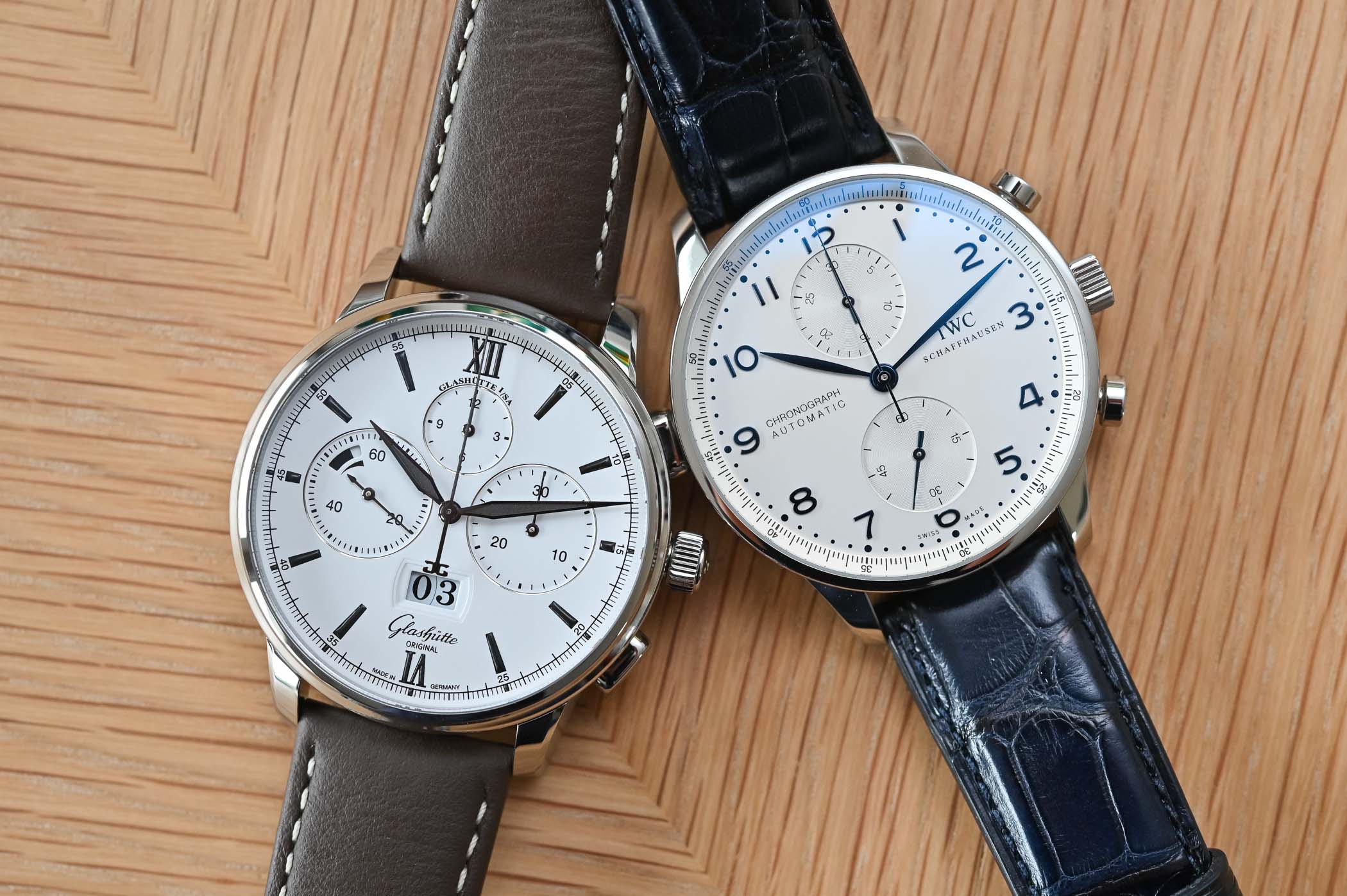
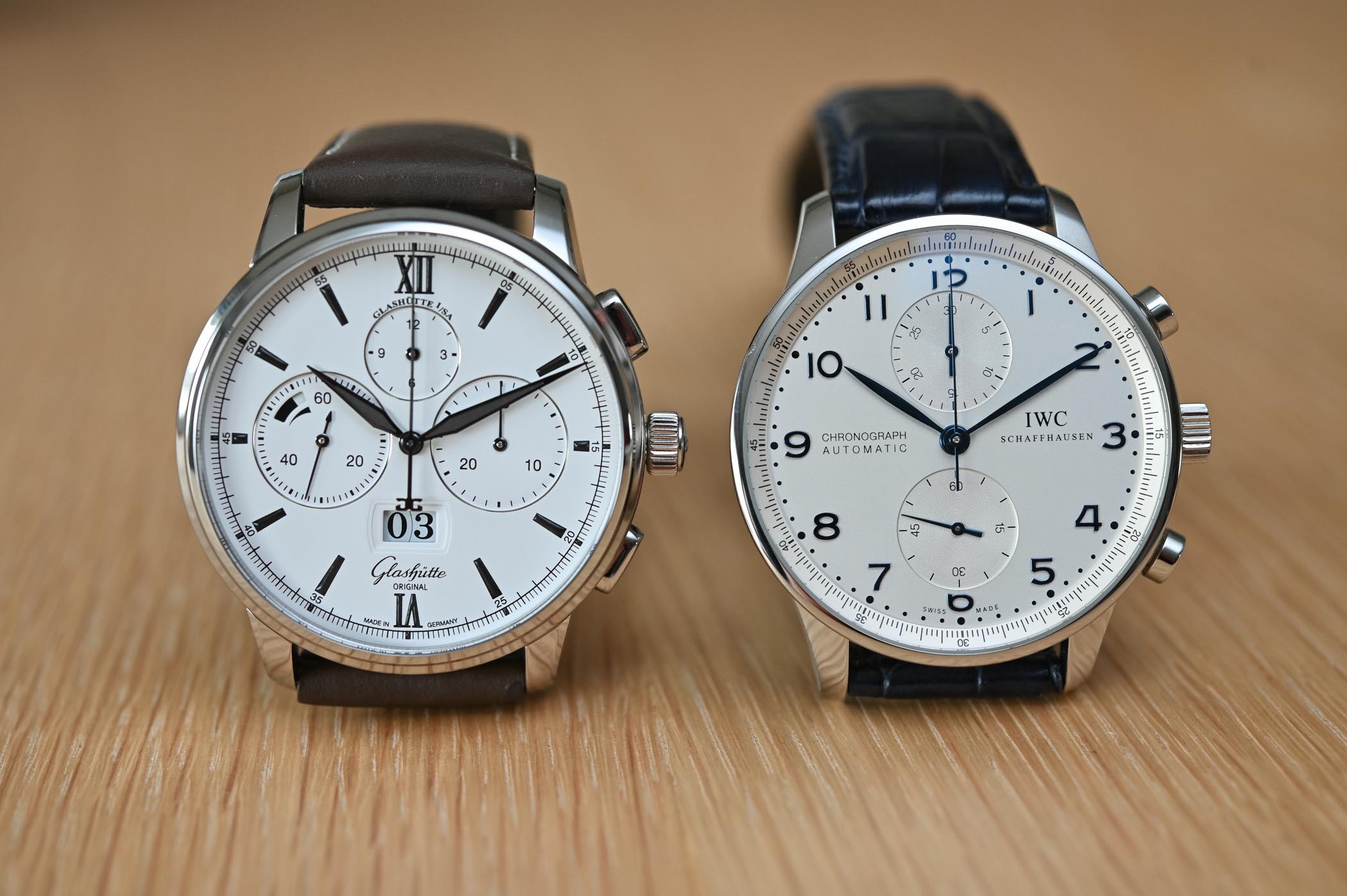
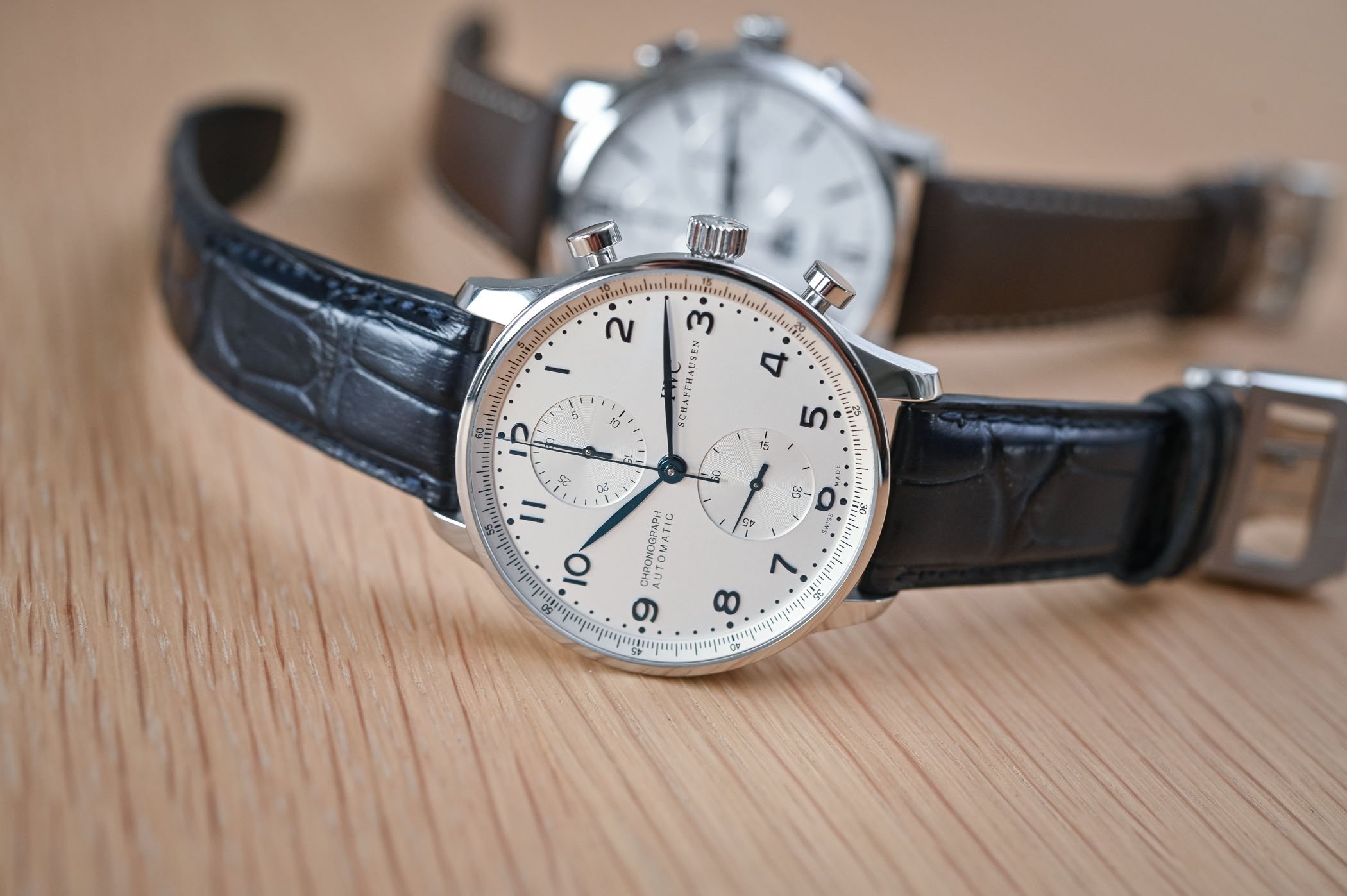
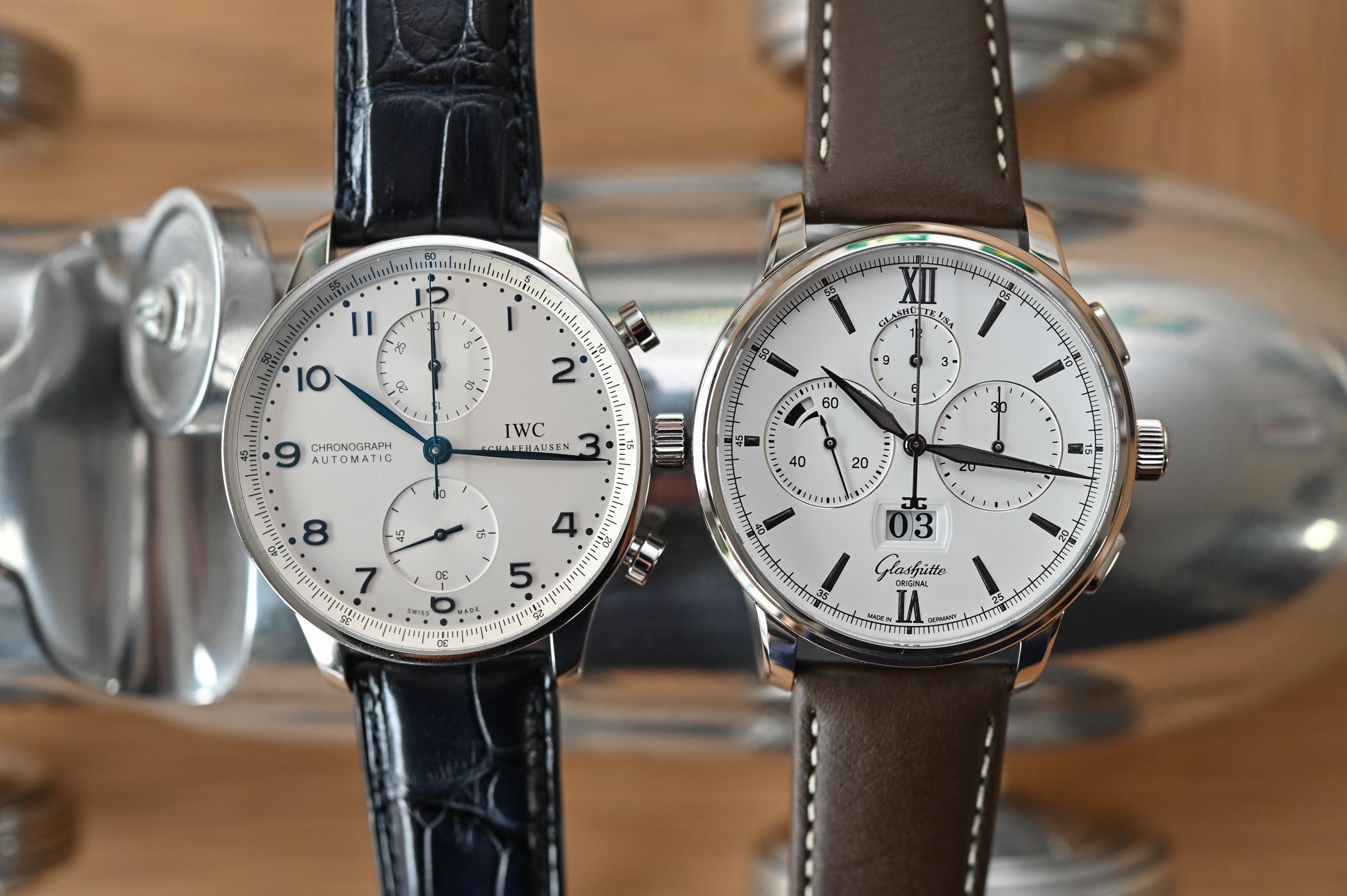
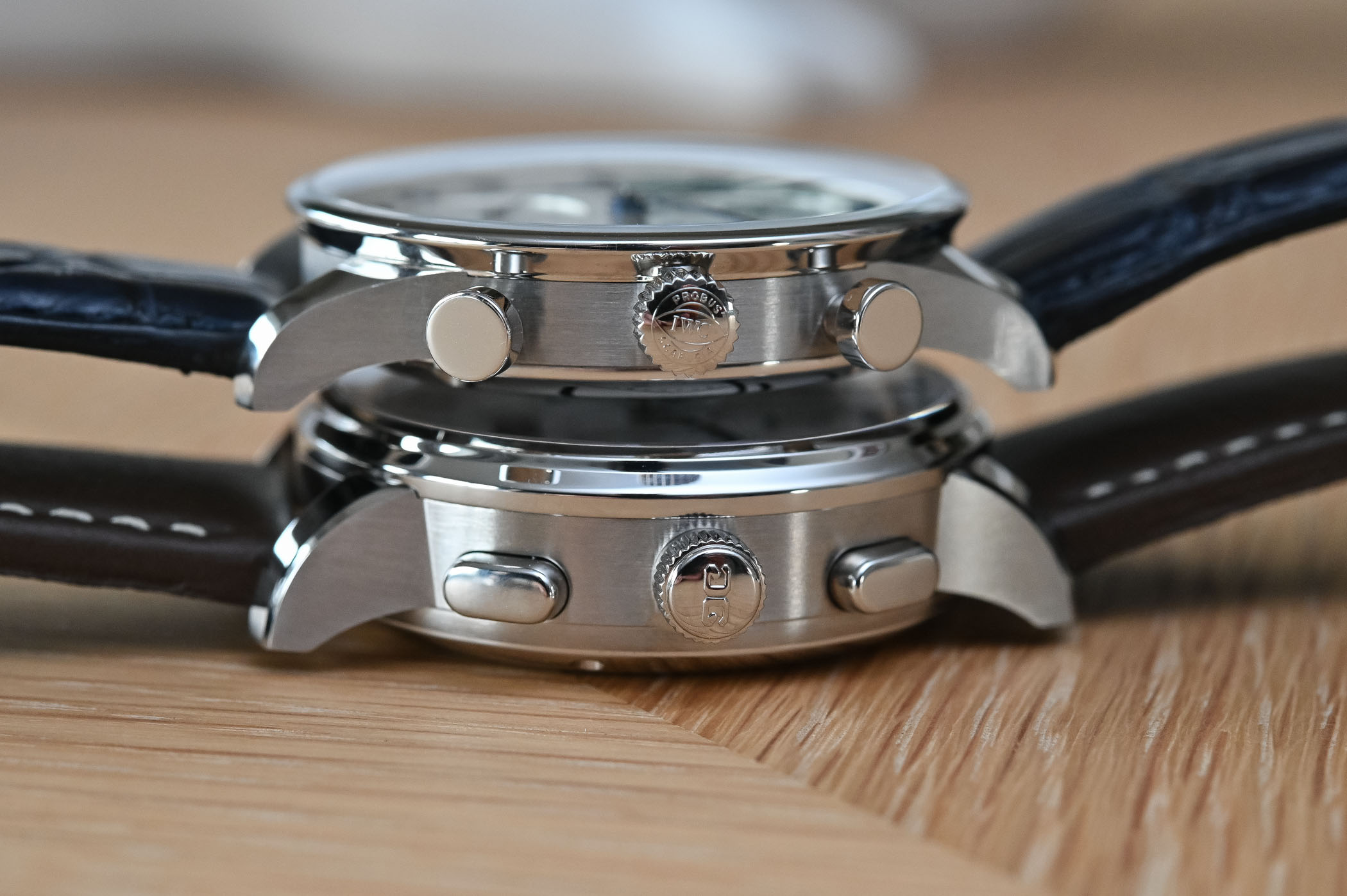


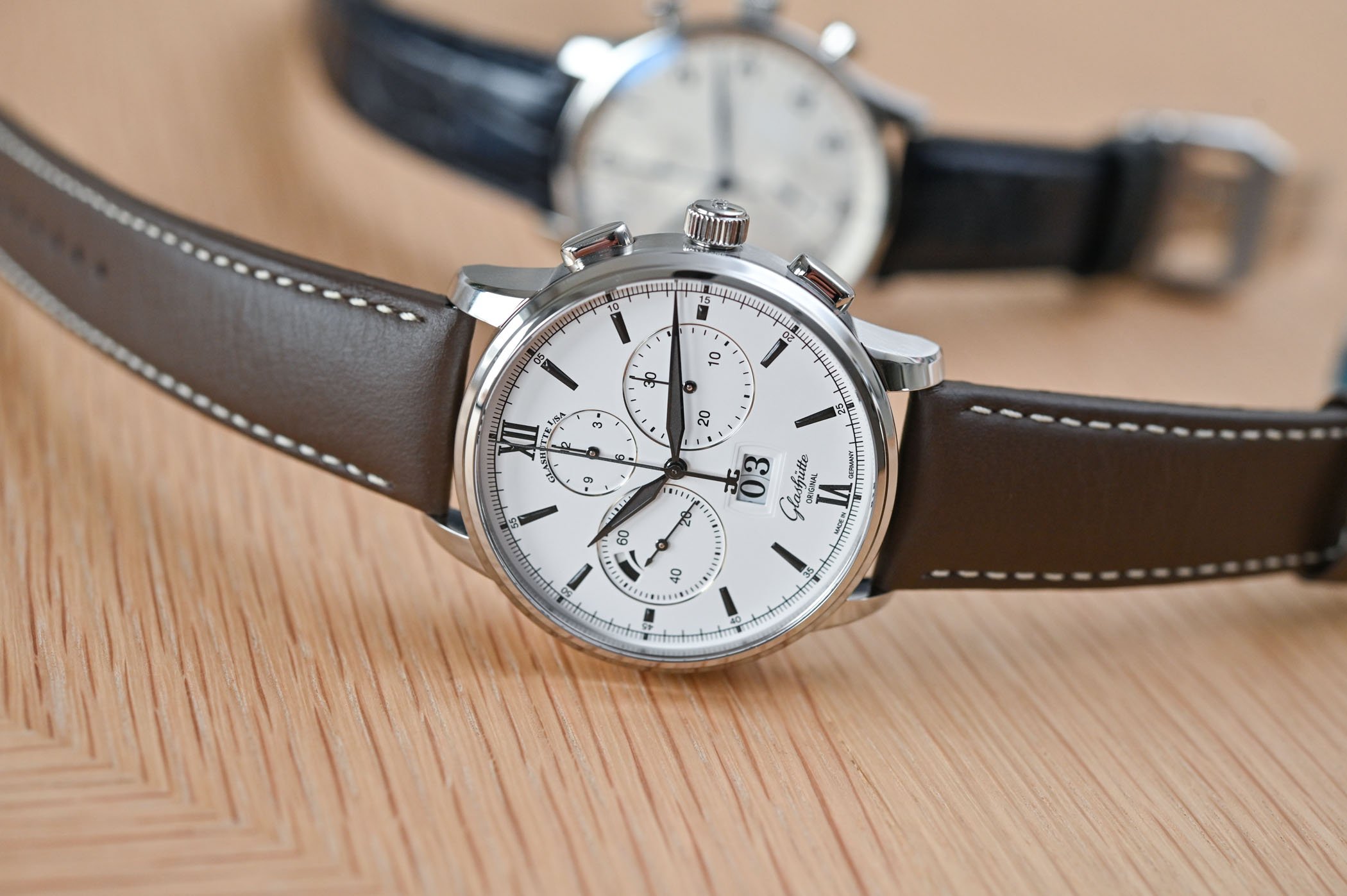

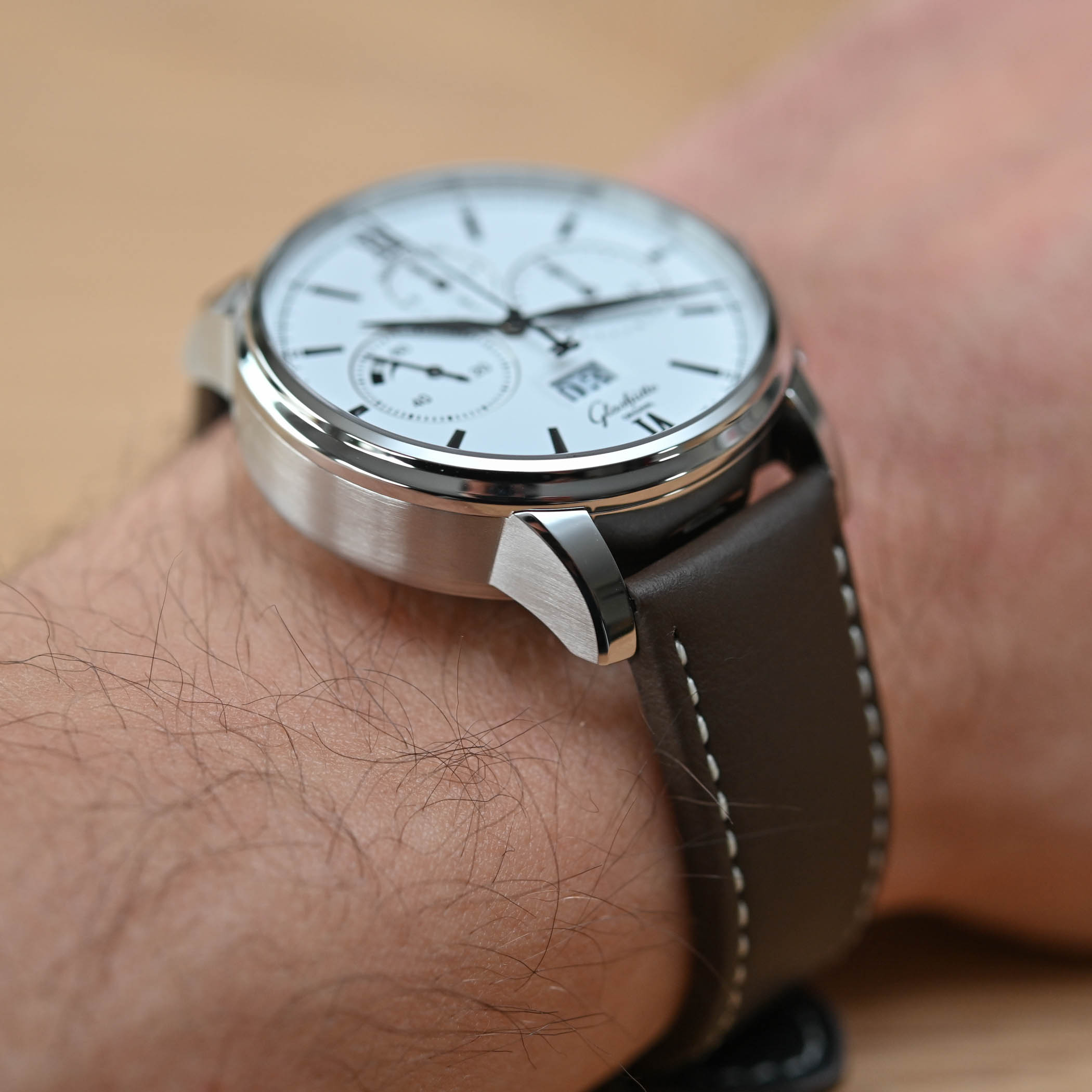
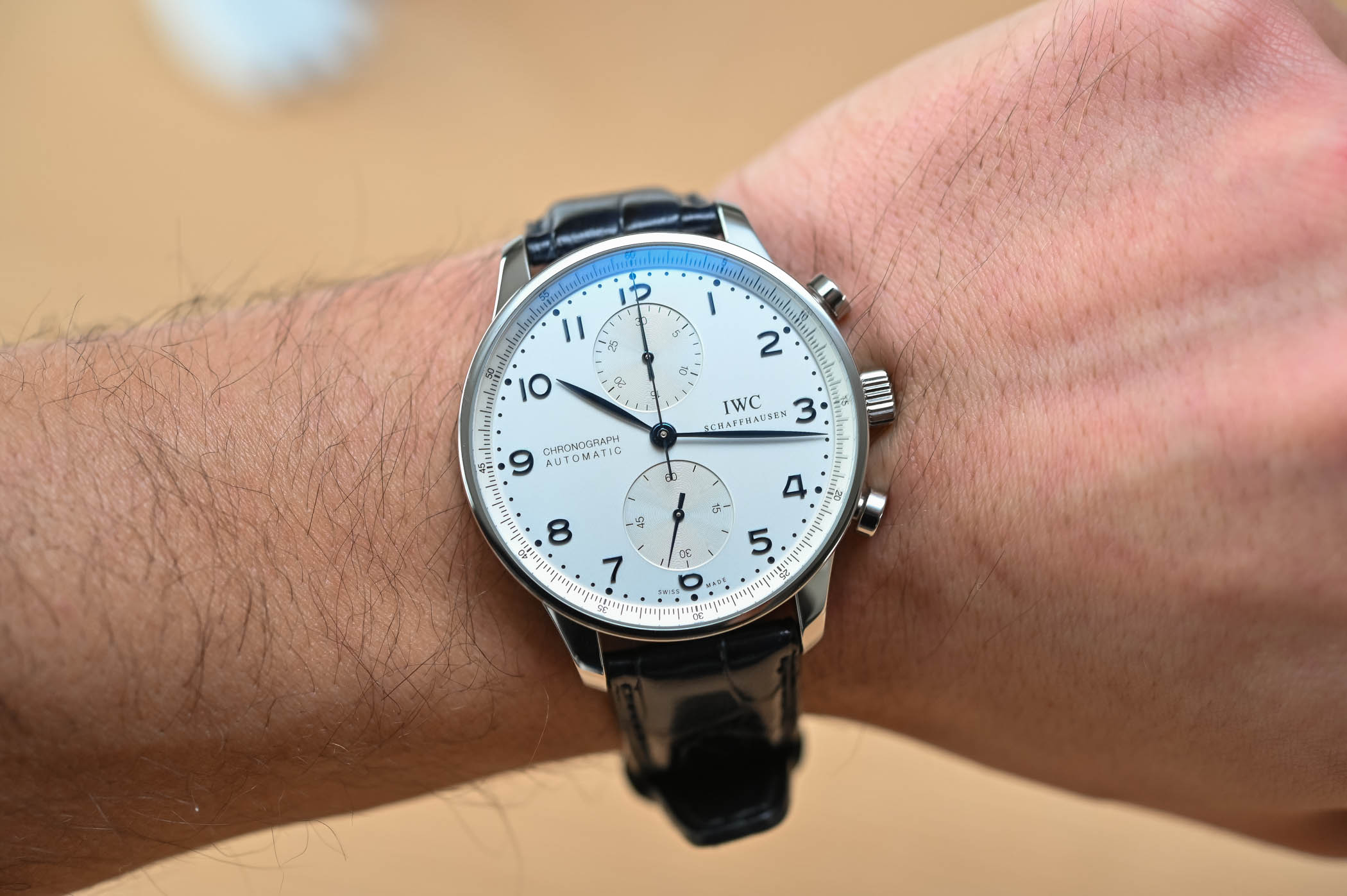
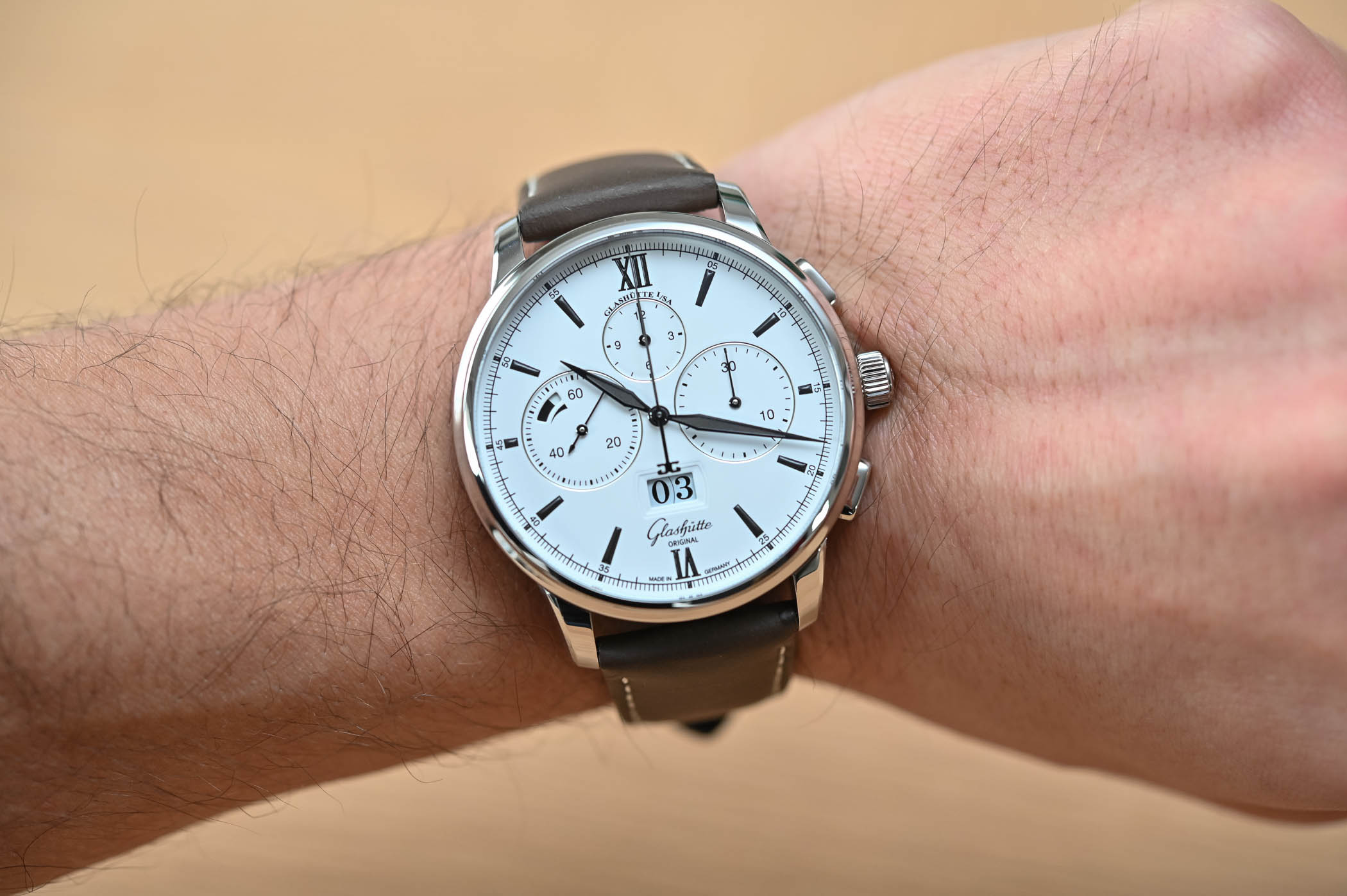
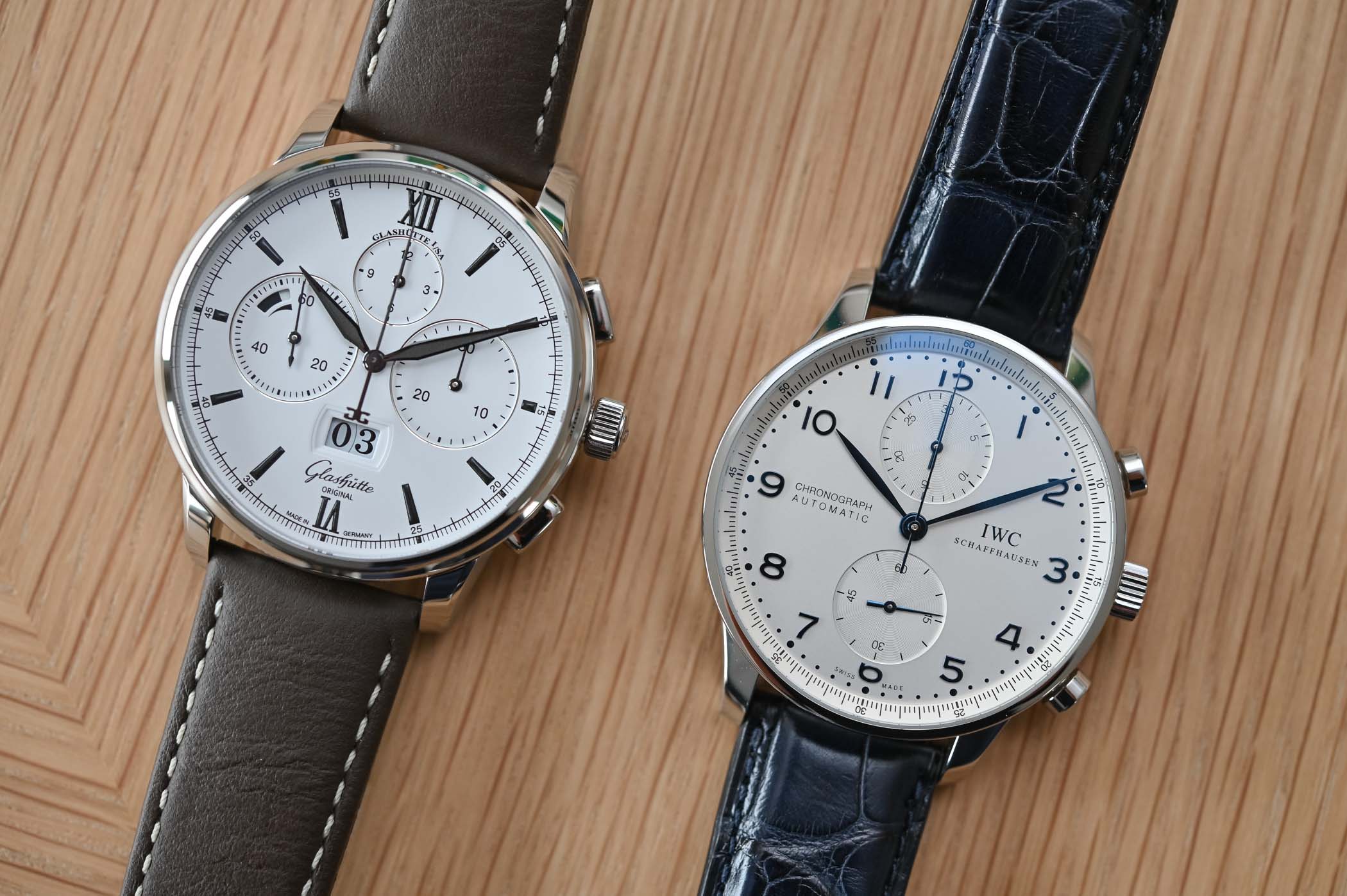
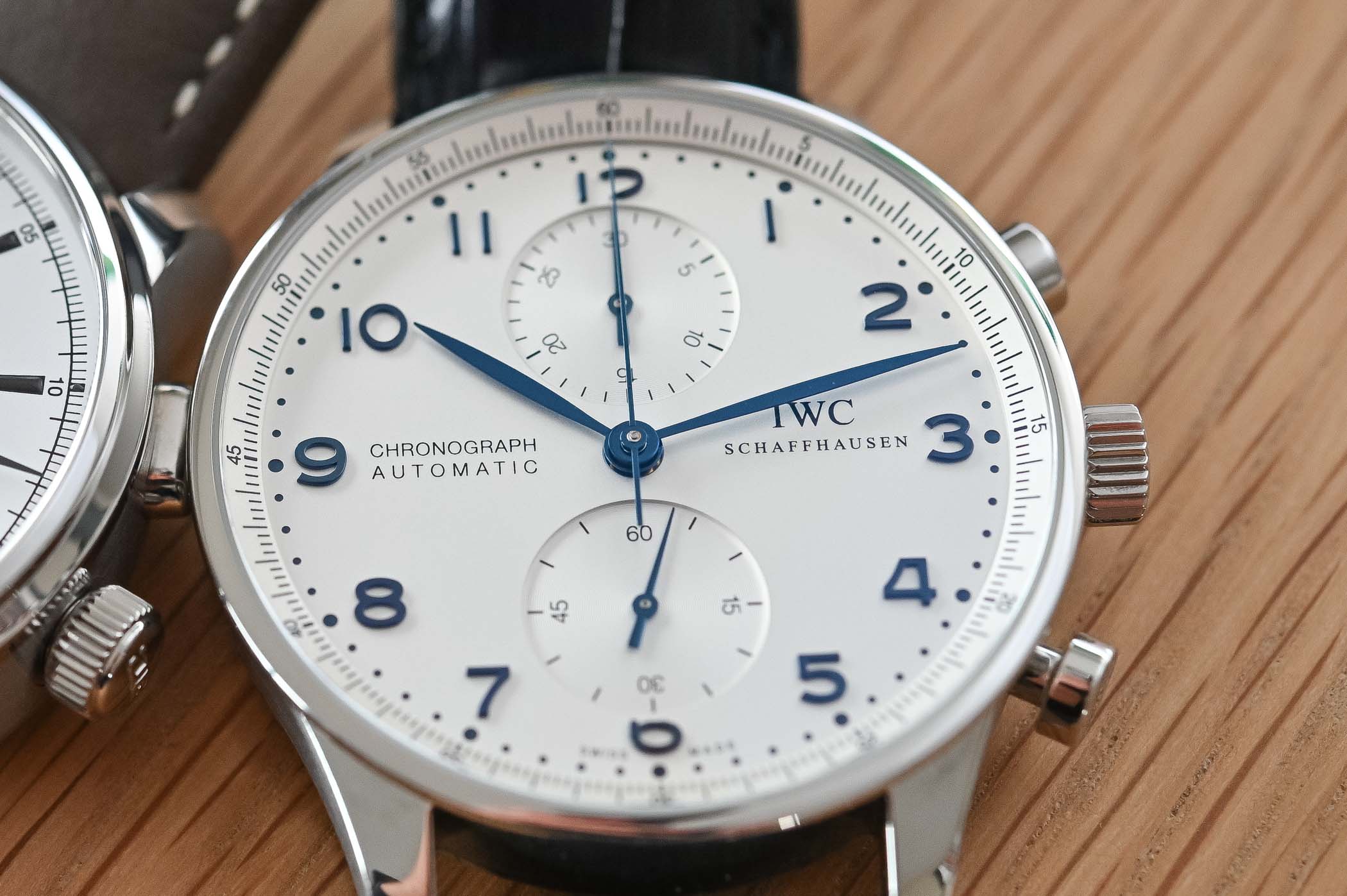



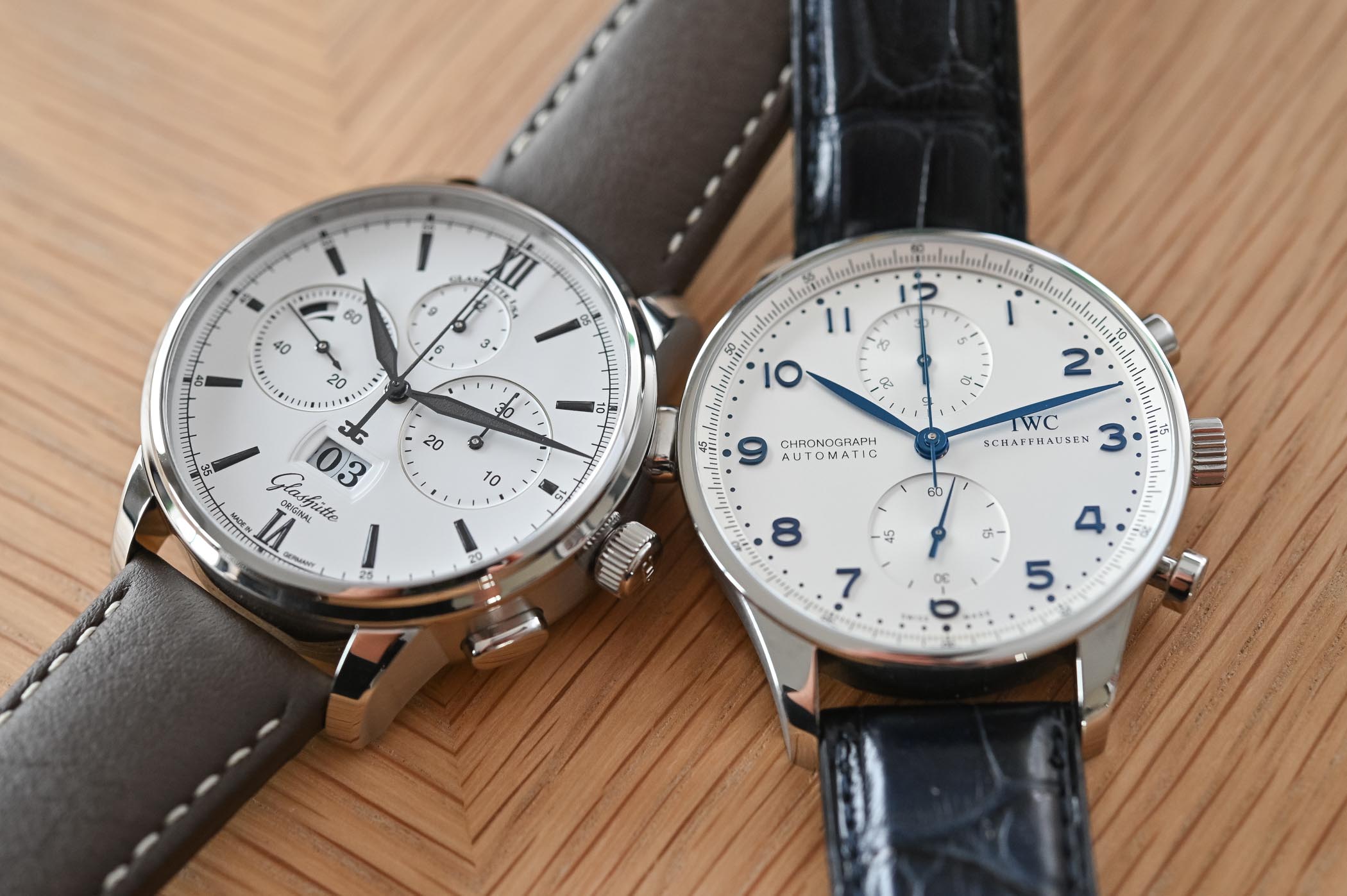



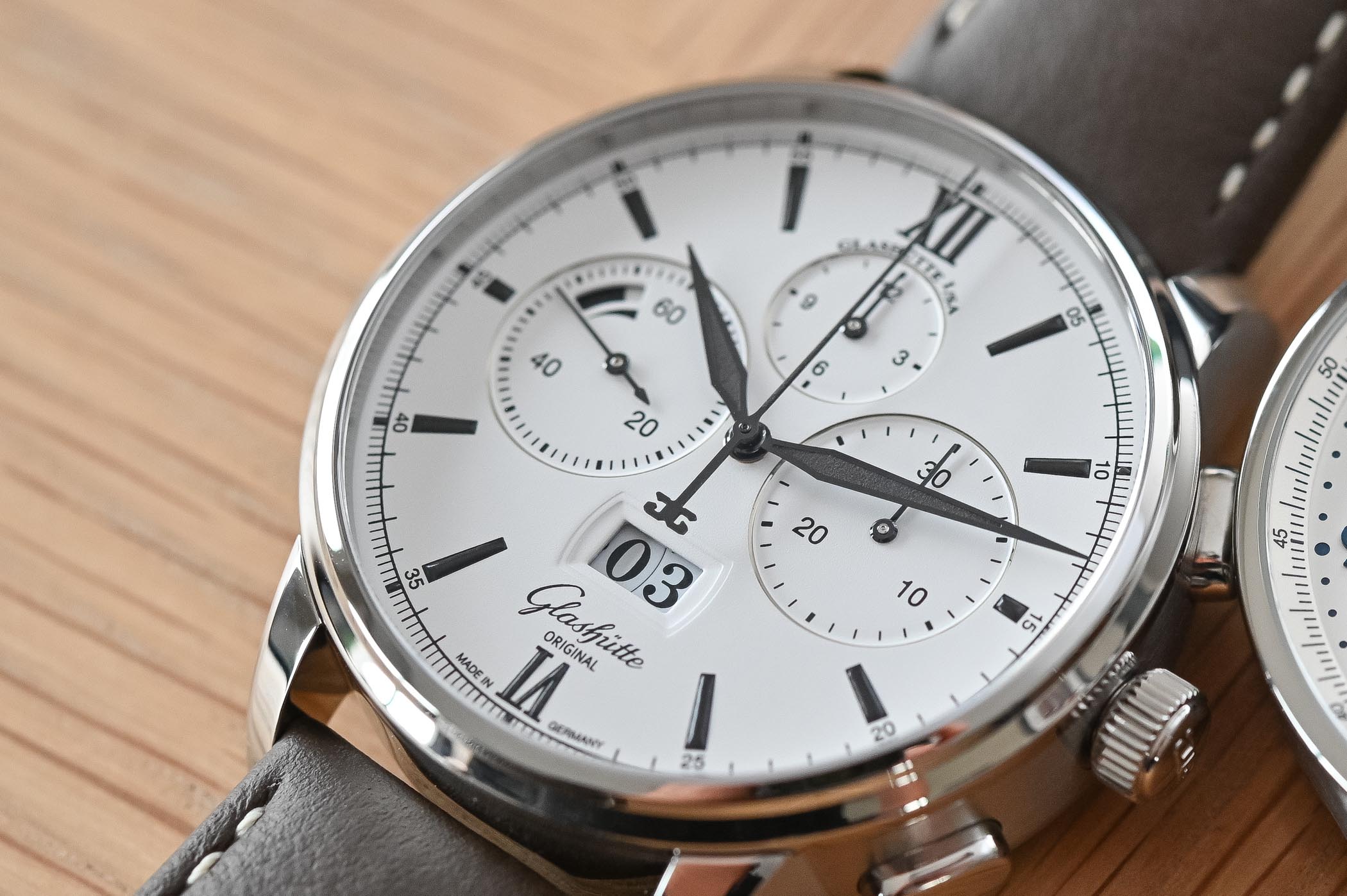
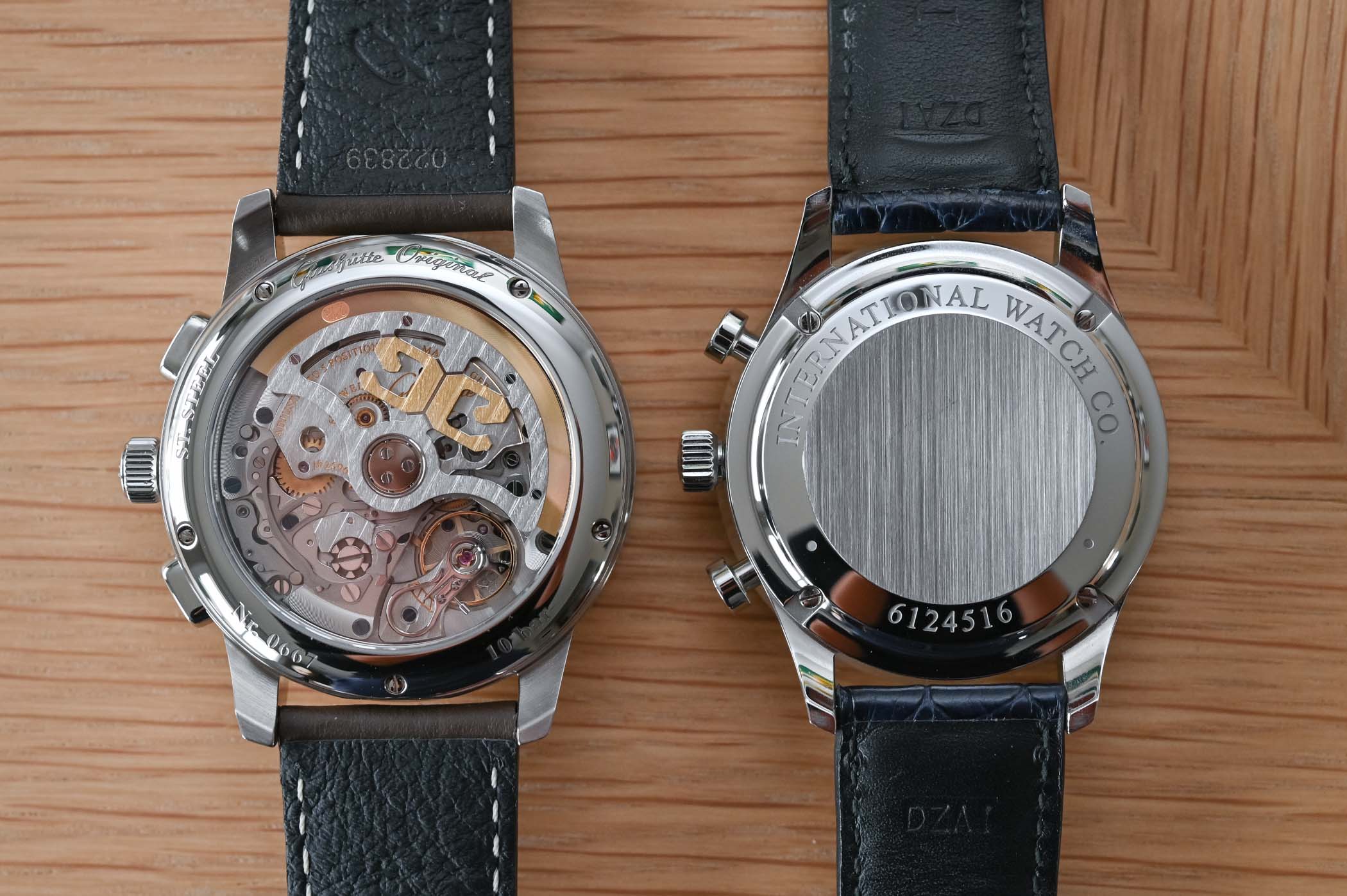


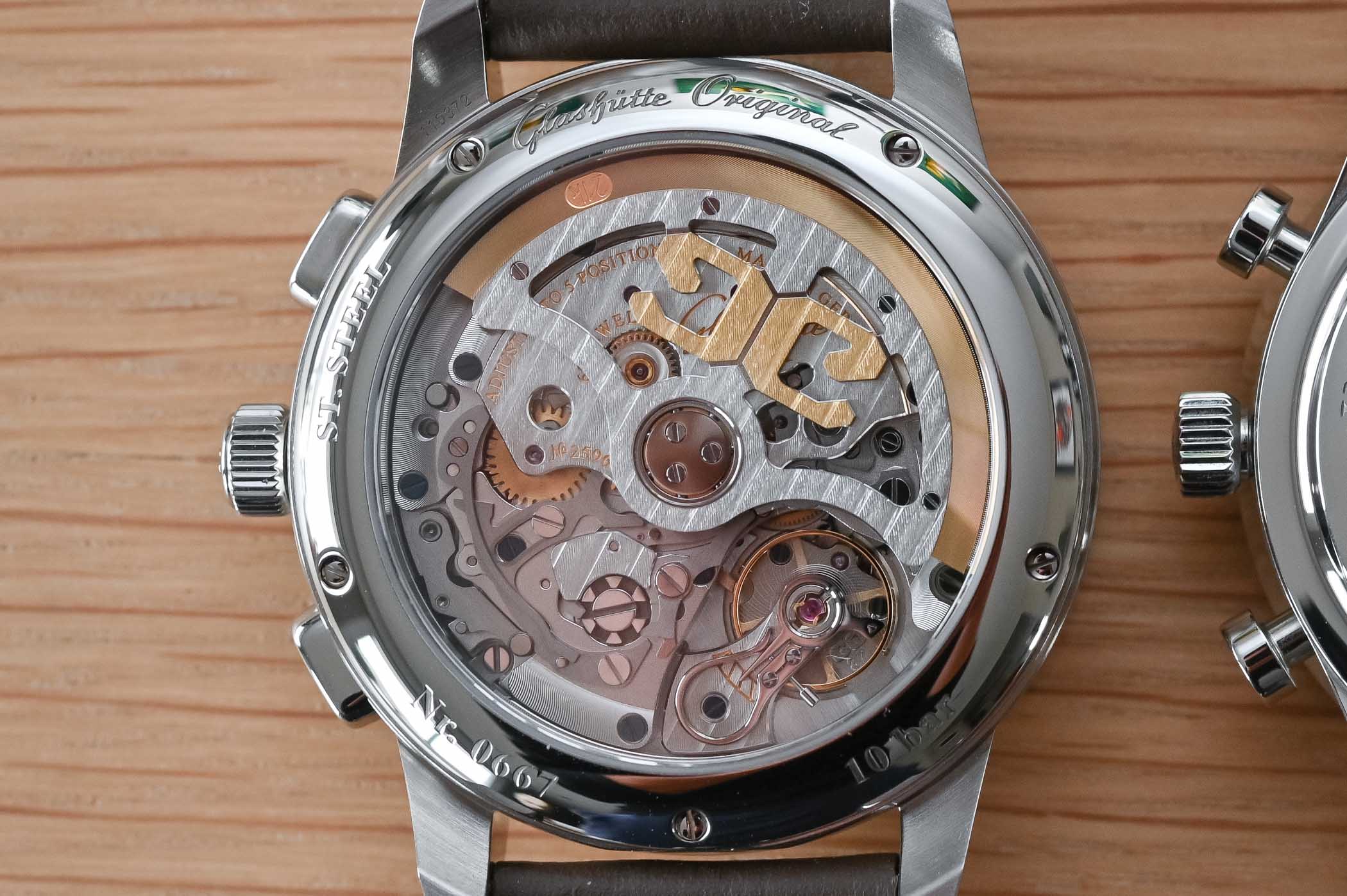
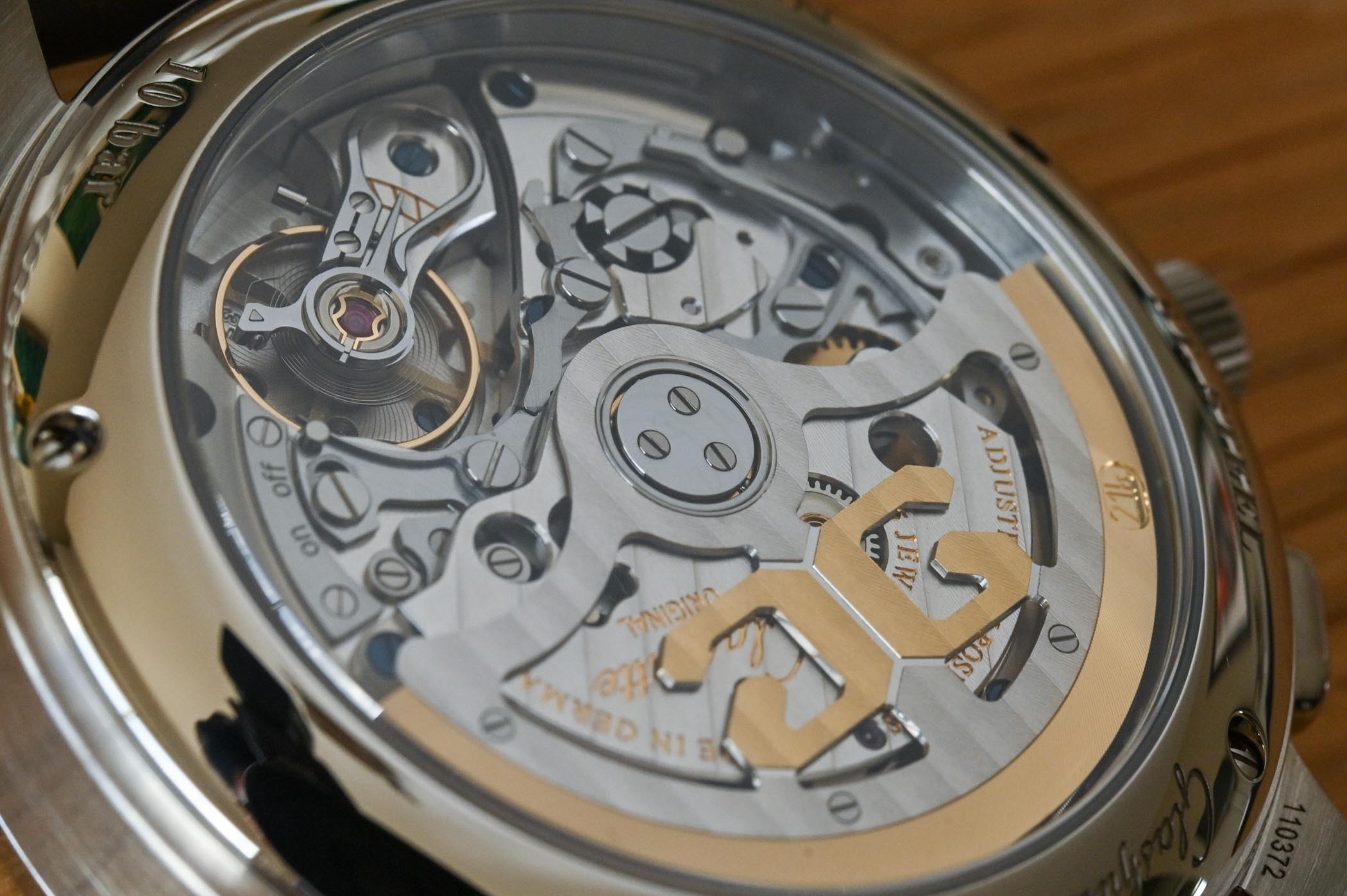



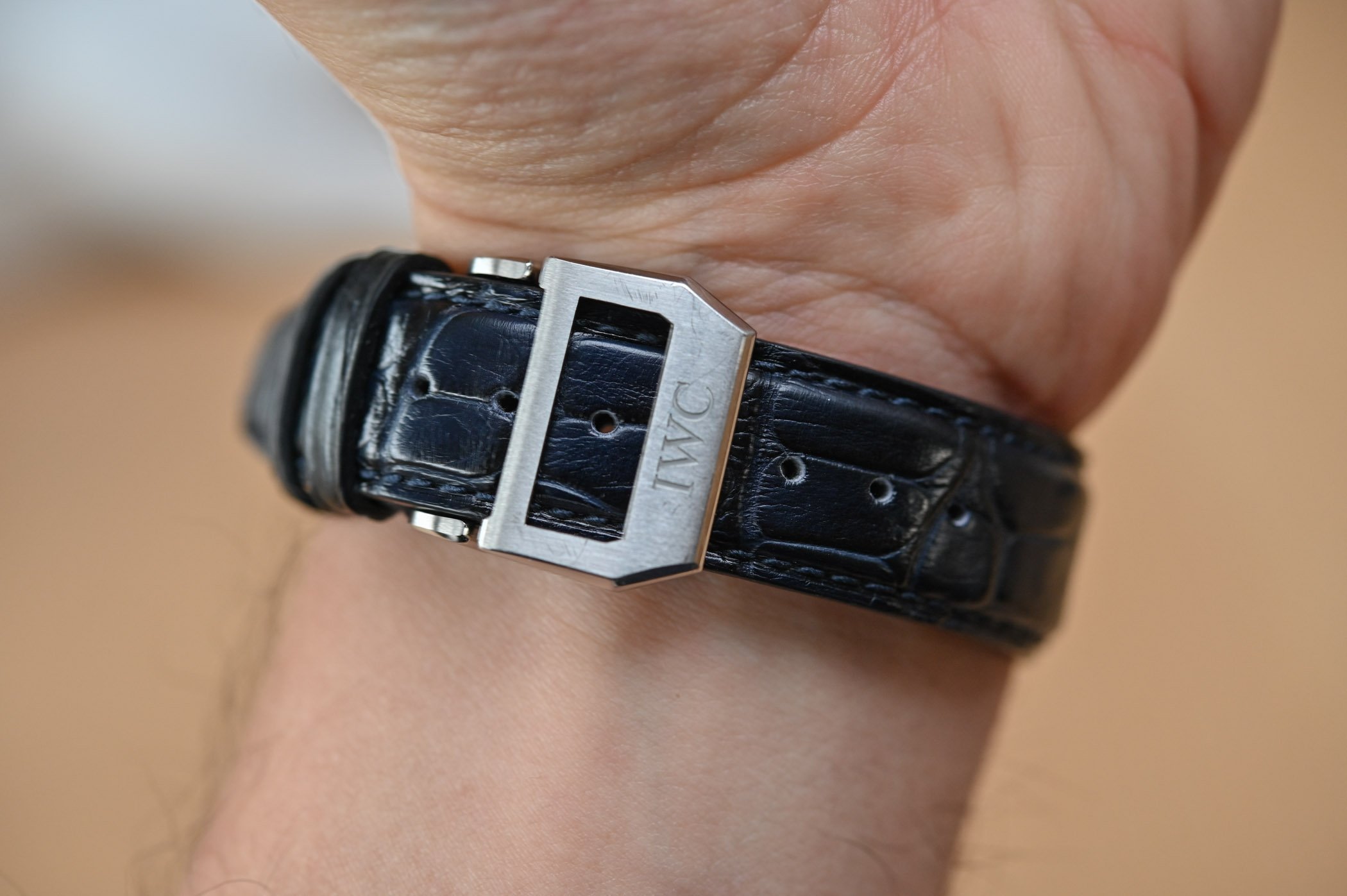
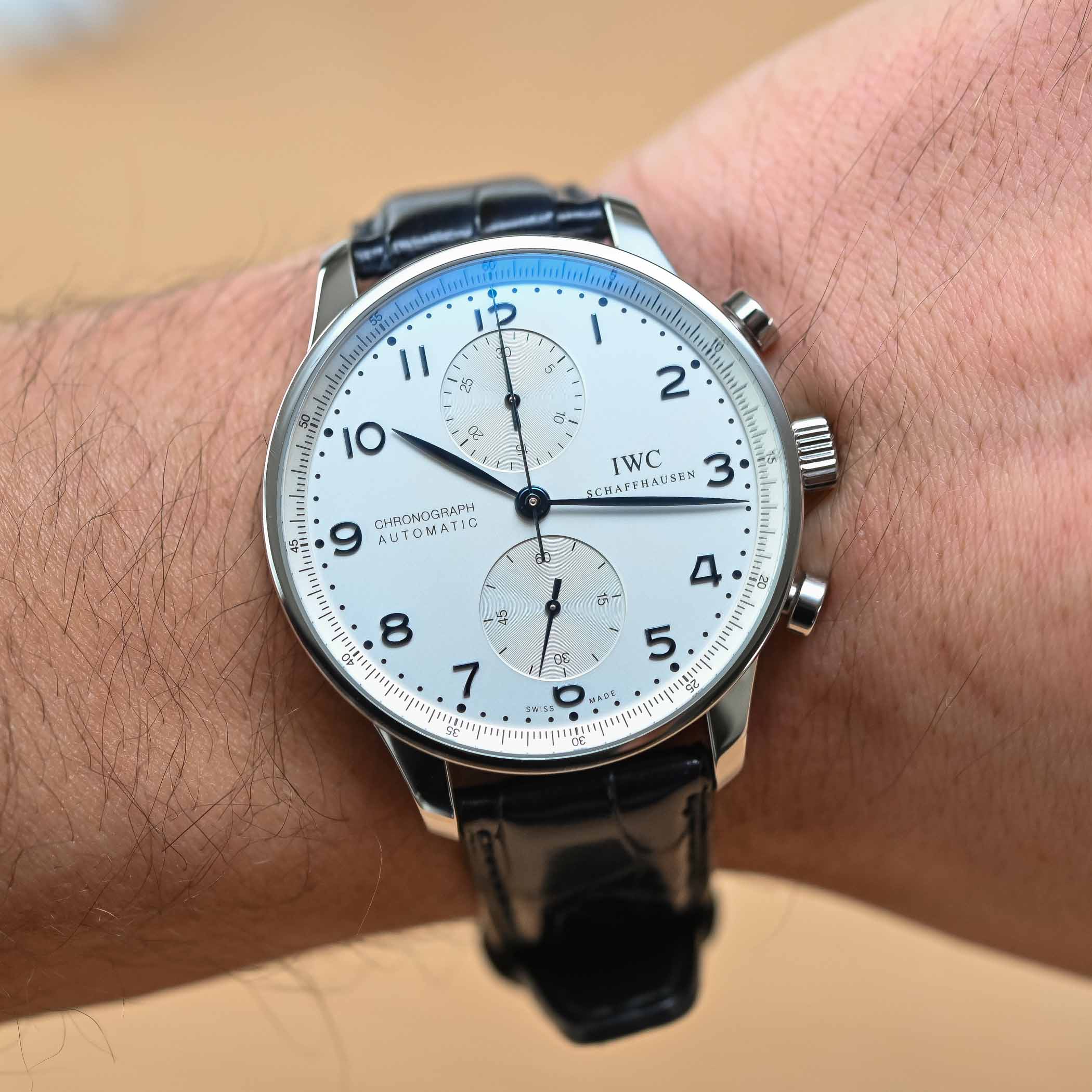
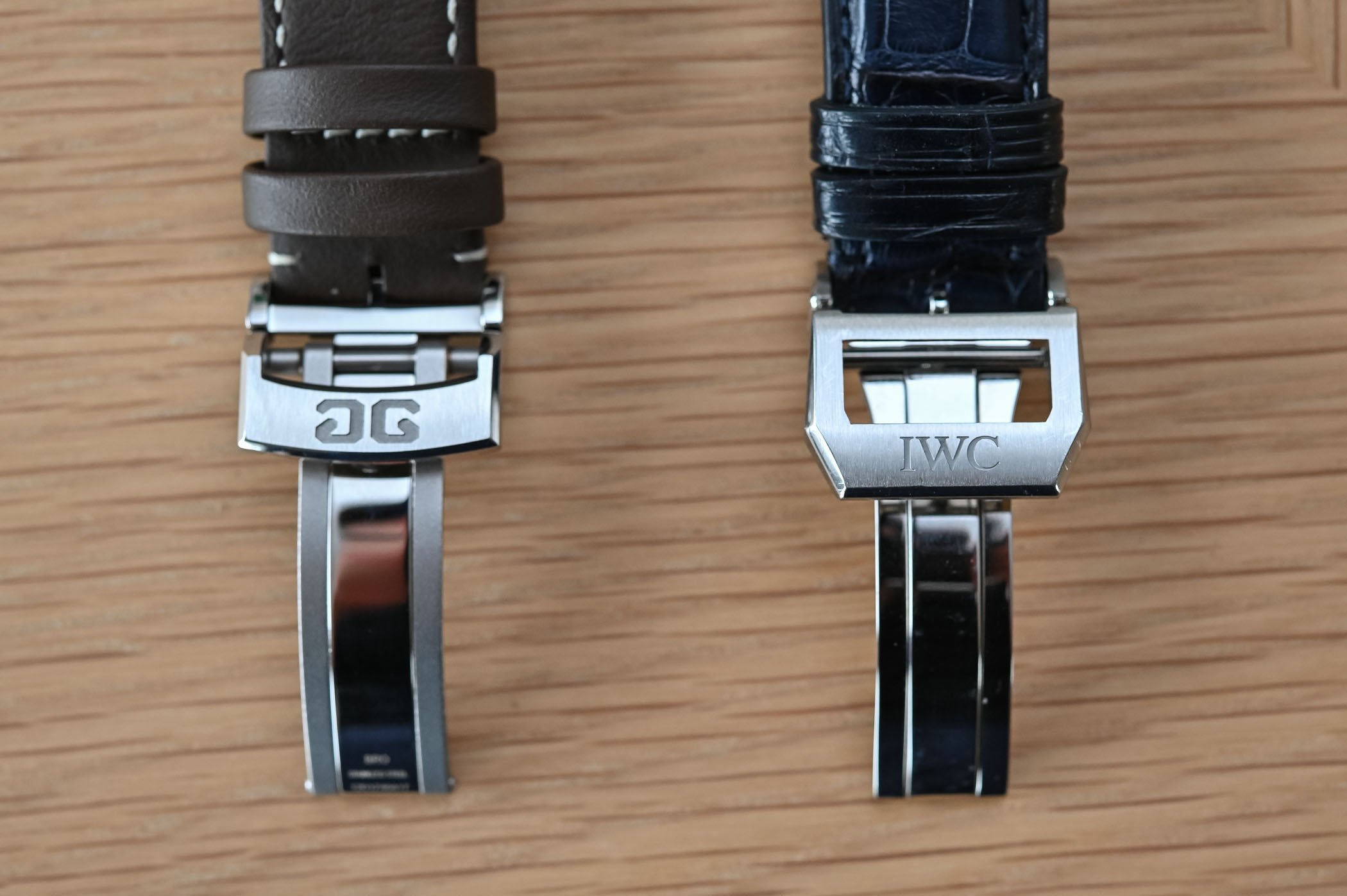
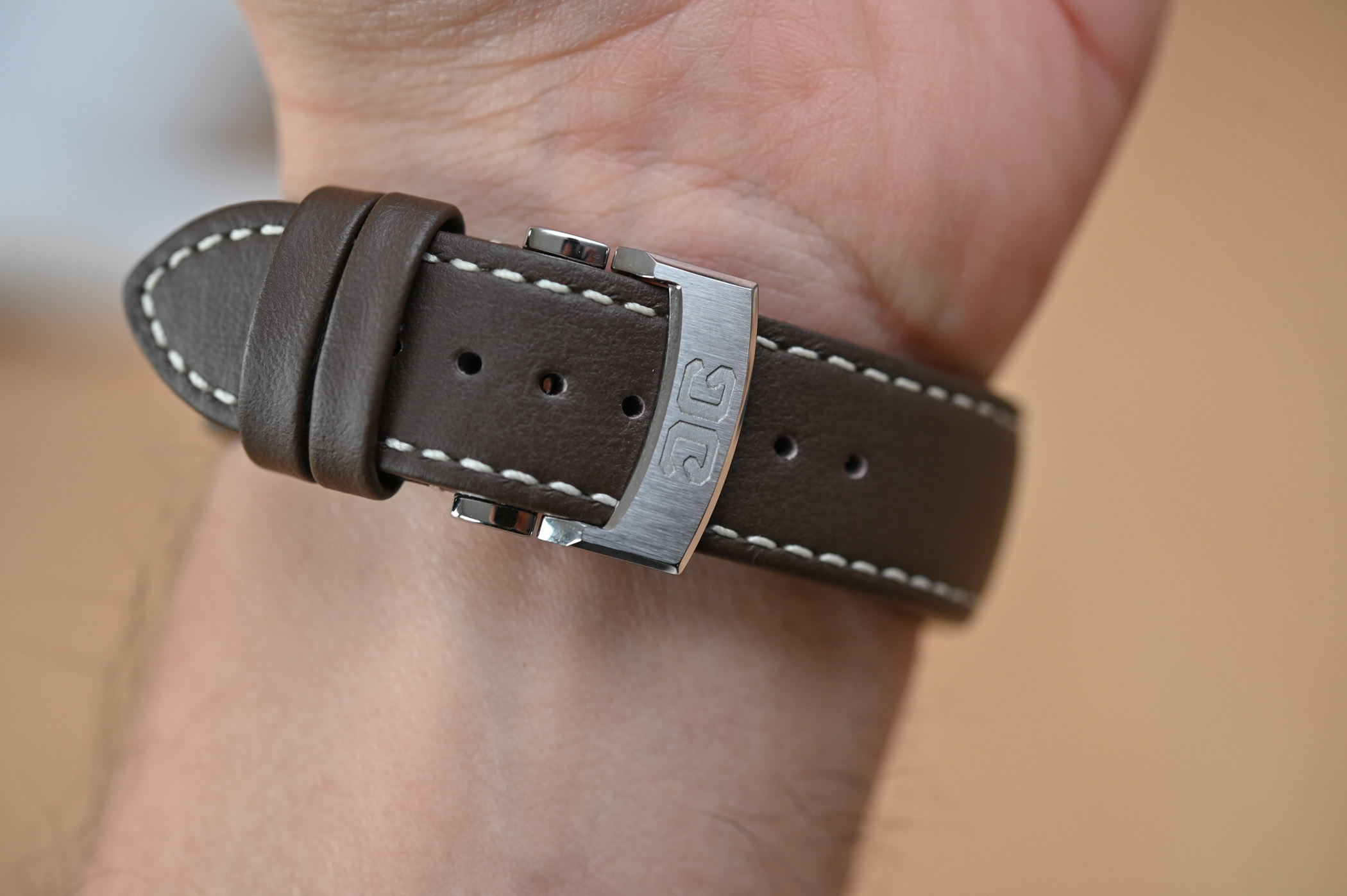
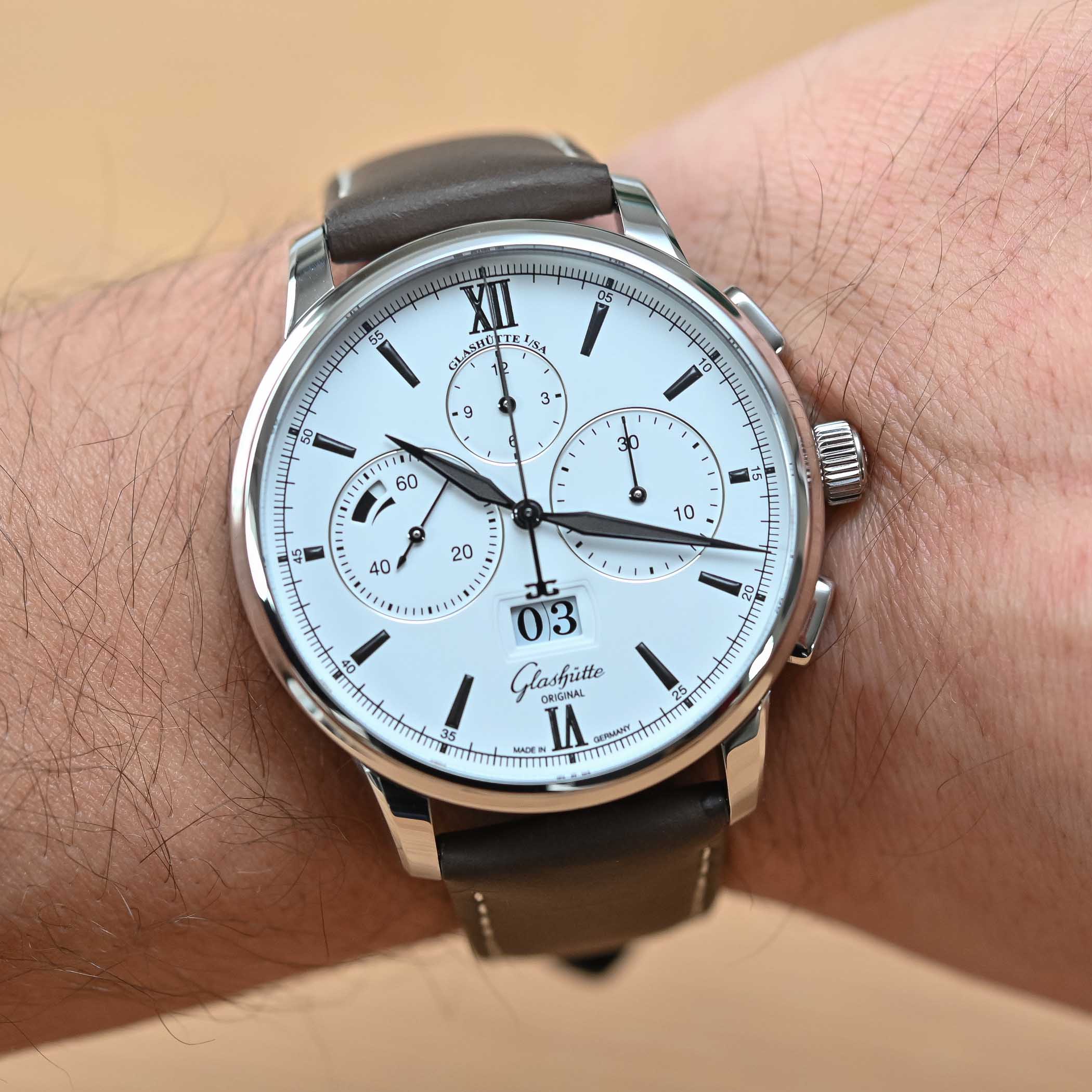
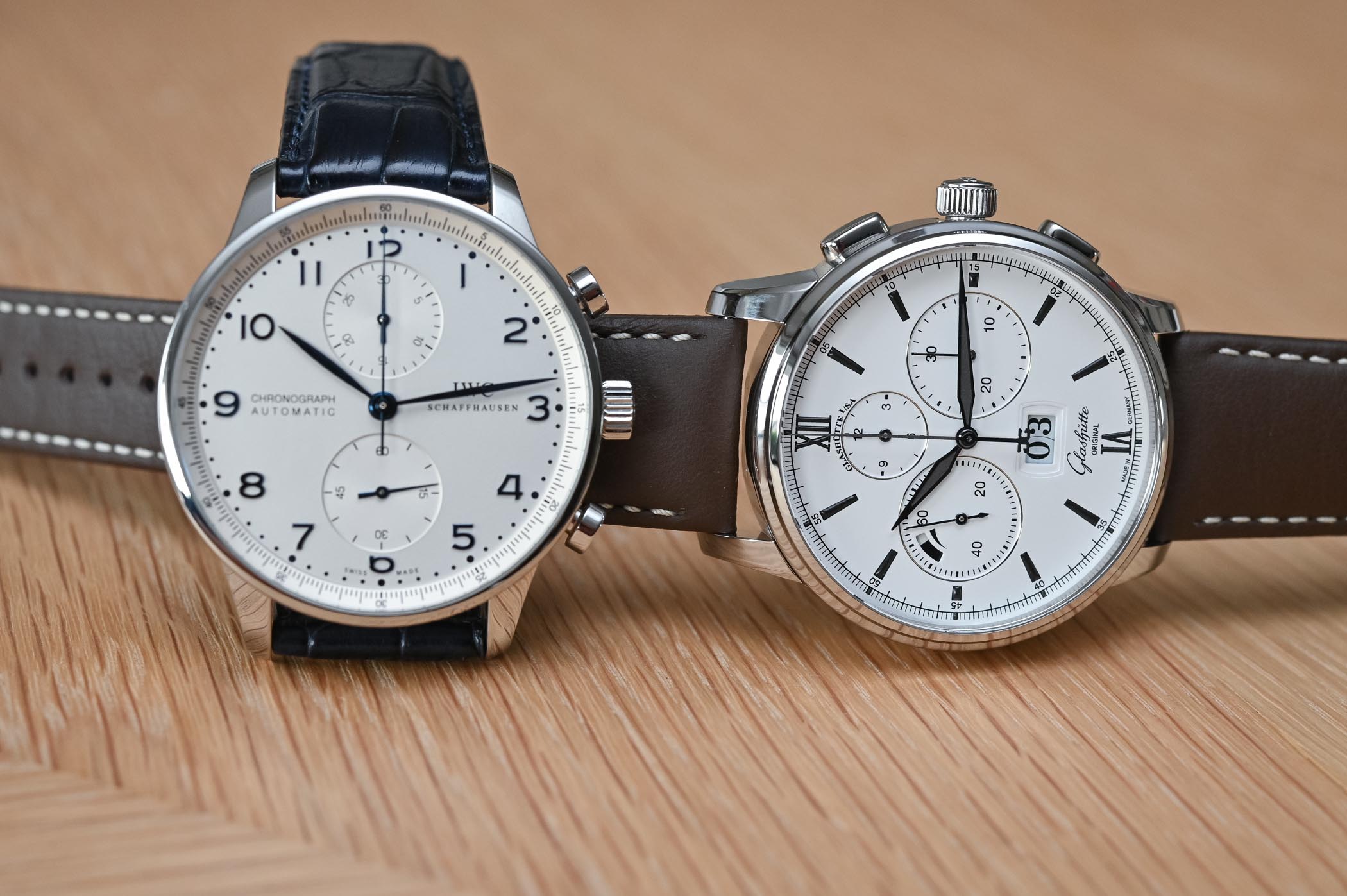
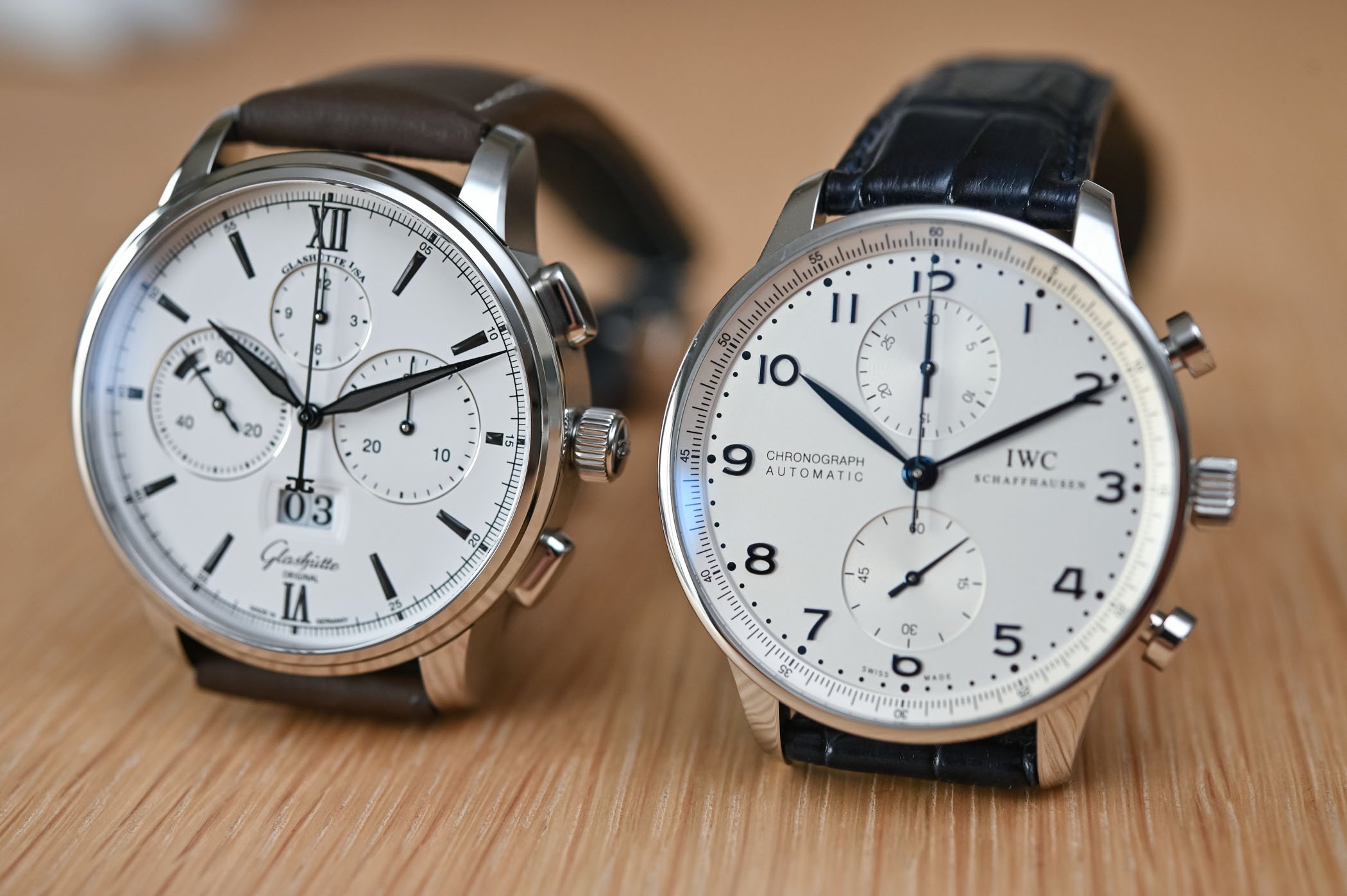
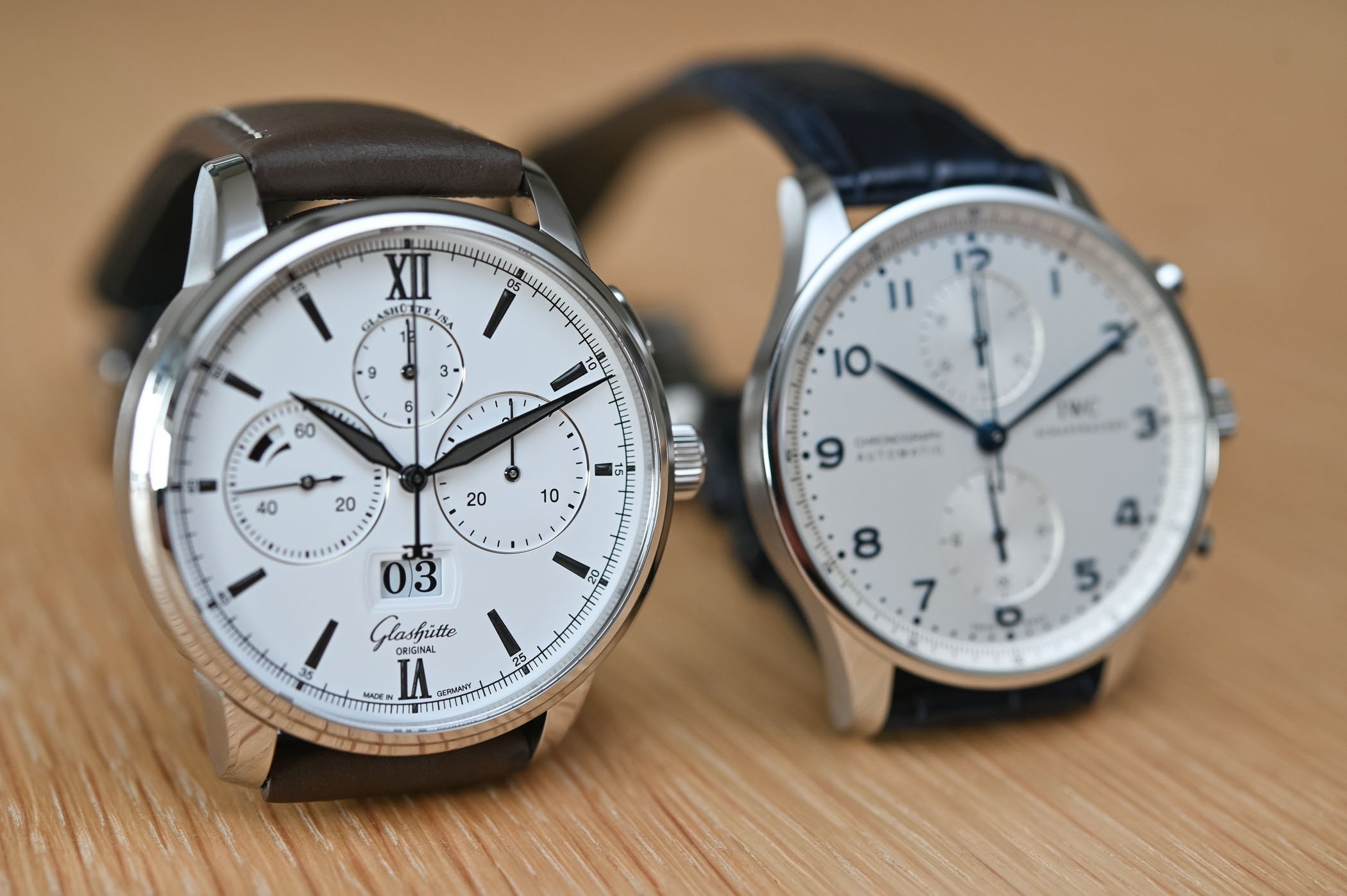
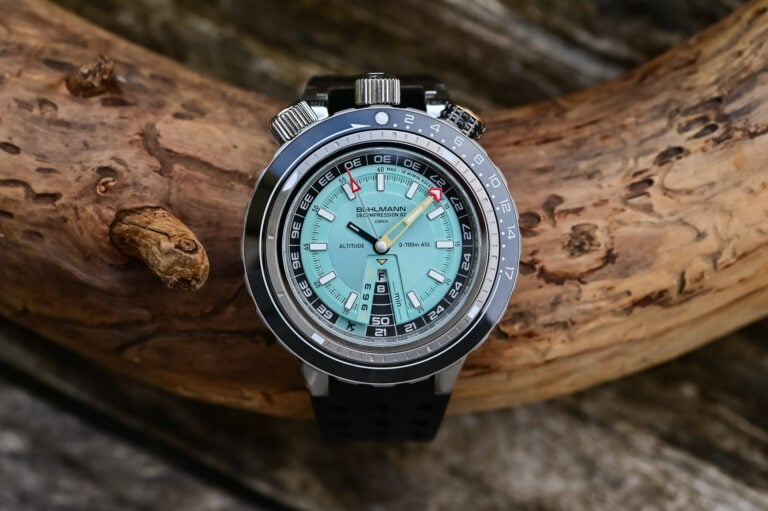
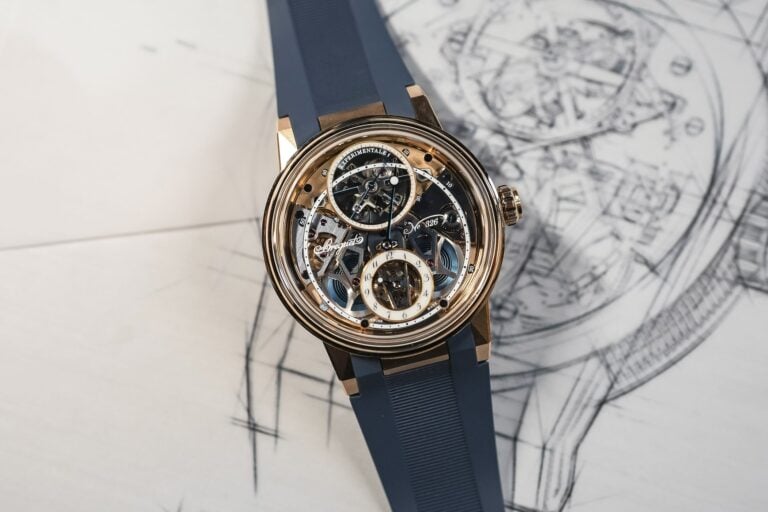
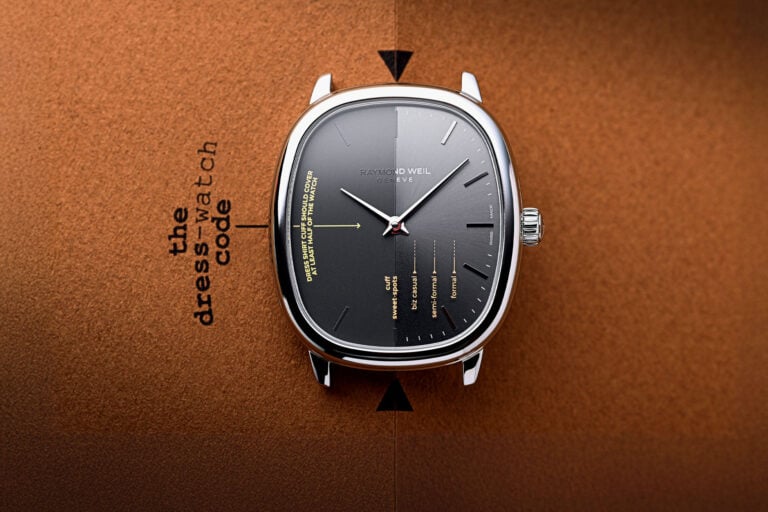
18 responses
Nice! Superb variety of photos btw, particularly the side-on ones.
Slightly strange comparison given the price difference – though I would also go for the IWC as I love its aesthetics. However, I might just note that 2 times 7,600 is 15,200 and not 13,200 (described above as exactly double the IWC price); still the comment is roughly true!
@Ian… oups, i should go back to the maths classroom!
Thanks Gil!
Excellent article. Perfect photography. A pleasure to read. Thank you.
Thanks for this well-written article, Brice! Though these two watches probably won’t join my collections, I still enjoy all your descriptions and analyses, which are spot-on in my opinion.
@Maitre – thanks for these nice words.
@Chia-Ming Yang – thanks 🙂
I have this exact same IWC (except the buckle) that I bought 5 years ago. I love the way it looks, so simple and “open”.
Unfortunately, I wear it less and less because I almost feel ashamed that it doesn’t have an “in house” movement. I know it is stupid, but you can read here and there people criticizing the movement and it tends to get to me…
Anyway, very nice article ! I like all the technical details. It is rely adding value to the review.
@Panpan – you shouldn’t be ashamed, at all! The Valjoux is a respectable, reliable, solid movement… there’s a good reason why so many brands still use it today… no one ever complained about the V8 small block engine. And yet it wasn’t a noble engine, but found its way in hundreds of GM cars, and prove to do exactly what people expected from it. So, as far as I’m concerned, the Valjoux is fine! Reliable, accessible, easy to service!
I already Have the IWC blue dial in my collection. But really like GO and would definitely add a GO sixties. I love dress watches more than sport watches.
both are swatch, pretty moaning in mechs;even beeing an ugly swiss i`d rather buy japanese for that money…
I have the GO in black with blue lime. I think the Roman numerals are to act as a reference point in the dark so you can see the 12 which you wouldn’t have in the dark without making sure the watch was straight up. Accurate to less than a second per day, fantastic instrument with exclusivity, don’t tell everyone what they are missing….great article…
Absolutely ridiculous Glashutte Original is far superior there is no comparison.
Loved the article. Both watches are great ,however I would go for the IWC
Ludicrous comparison here. GO is a higher level. So many differences and overall an unfair comparison. Compare IWC to Breitling and Zenith next time. Compare GO with GP and Jaeger.
Glashutte Original is on another dimension. The hand finishing on case, dial and movement is superior to the IWC which is evident in the photos. Glashutte Original are also far more rare than IWC. IWC is very much an industrial watchmaker.
I own a Pilot that I love and that is wonderfully accurate but to my mind GO is in another league entirely. My Pano Moon Phase in blue and a delicate and gorgeous older Senator chrono are nigh on perfec. No contest.